#basically i enjoy this franchise but its in spite of it all half the time i stg
Explore tagged Tumblr posts
Text
Watching man delorean season 3, halfway through and...... ok
So far this seems like 100x more of a random side story than book of boba. Which wasn't a side story at all because it literally progressed the plot more than 90% of these first few episodes of pissing about with the mandogang.
There's been about one episode's worth of compelling plot and a bunch of mr. lorian doing sidequests
The prequel flashbacks got me dreading the moment this ties in neatly with the fucking obi wan show because fuck me
Is this all elaborate juggling for 5+ years to explain Somehow, Palpatine Returned. Since we've finally brough back the clone research sub...plot which was the plot plot of season 1. Remember plot....
I know its because it Literally Is at this point because baby yoda wholesome meme phenomenon but this feels increasingly like a PG-13 Disney Property. (bc it is)
Every moment they try to do straight faced like... training moments with baby yoda is terrible. Because its all just the 'furrow eyebrows and lift rocks' shit from like season 1, repeated. And they're treating this 30+ year old baby like a 5 year old child but he's still dubbed with the sound effects of a real human 6 month old who is burbling because he's really focused on taking a dunp
Why is star war
Andor was pretty good though. The b plot in one ep about werner herzog's decorative lawn scientist was neat. But still lending credence to 'book of boba was the scripts for like half a season of mandle combined with the scripts for what was supposed to be an actual, shorter fettshow' theory because the stuff that isn't mandle sidequesting feel like the other half of that season.
And all this echos of studio fuckery is years before the writers strike so good fucking lord how bad are they going to do with their apparent plans to go ahead produce more of these shows without having the writers on set or available for revisions.
Why is star war
4 notes
·
View notes
Photo

@amratsu Now, if it was solely down to my own personal bias, I would have just put them in the original list and called it a day. However, my aim with the original reply was to avoid tripping into the trap of overwhelming a request for recs with way too many options, but also, first and foremost: I was asked which would be best to start off with. In retrospect, I could probably shuffle some entries from the second list into the original one, but I basically wanted to go with three of the best options based on certain specific criteria:
- Kuuga because it has the most cohesive vision from beginning to end. I would rate it the best, to the point that the one caveat that would have earned it a spot in the “check these out later if you ended up growing to like tokusatsu” are the dated visuals. It’s just an incredibly solid, tightly written show, not just tokusatsu-wise, and one which I think those who love analyzing the themes of a story would greatly appreciate.
- Ryuuki is one that, for one reason or another, has ended up as a beloved favorite of pretty much everyone I know, and for good reason. It’s a bold show, but way more accessible than Kuuga, and I think it would set the bar pretty high for one who just got into toku shows. It also suffers from dated visuals but at this point, if that’s such a pressing issue for a potential viewer, it would be hard to recommend any toku shows at all.
- Fourze, well, it’s just plain fun. I really can’t imagine anyone who wouldn’t enjoy the ride if they got into it. The setting being inspired by American school comedies would no doubt resonate with Western viewers in an endearing kind of way too, which definitely would help with the series’ accessibility.
I think I would go as far as considering these shows “quintessential”, in that together they form a trifecta that captures much of the charm and features of the Heisei-Reiwa Riders as a whole.
I think W would be the easiest to rec out of them, and I think the only reason I didn’t put it in the original list may be because its latter half didn’t leave as strong an impression on me, although it has been a long damn while since I last watched it.
OOO lives or dies by whether you love or hate Eiji and Ankh’s relationship.
Ex-Aid succeeds in a frankly impressive fashion in spite - or, hell, because - of the absurdity of its premise and has some truly amazing emotional beats, but I fear that it would be a Lot for a newcomer to the series, for one reason or another. I think most people would like it, but I have also heard there are some divisive opinions in the fandom as a whole about it? I don’t know, I personally loved it, but there you go.
Zero-One is one I wish so badly I could recommend nilly-willy, but I don’t know how it would feel for one to experience the latter half without the weekly buffer between episodes. Some people think Amatsu and the competition arc were the series’ low point, but if you ask me? They were both fine, barring the robot dog thing that’s part of the COVID phase anyway, so I can at least forgive that. My real problem with the series is that it fucking mishandled Yua so badly man, the payoff was satisfying but GOD did we sit through some ridiculous bullshit before that...
You might have noticed I hesitated to include Den-O in the list. I think it’s mostly due to the fact that Ryotaro’s personality might get to some people’s nerves, plus the story getting a bit awkwardly confusing at times. I definitely think it’s worth watching - it’s no wonder it’s one of the most popular Heisei series in the franchise - but I would hardly recommend it as part of one’s beginner course.
In the same vein, as much as I love Agito (which was my introduction to the series), which somehow managed to be incredibly good despite being written by Inoue, I think it simply has the misfortune of being sandwiched between Kuuga and Ryuuki, which are both way more likely to be palatable to a great number of people.
3 notes
·
View notes
Text
The metanarrative’s grand narrative: Osomatsu-san’s characterization throughout the franchise
The growing cynicism throughout the entire Osomatsu-san franchise shows itself in season 3 with more prominence than anything prior. I think that’s pretty common amongst any “long-running” gag comedy - replacing a plot with spiteful commentary that’s admittedly pretty hit or miss at times. However, it invariably creates a negative but pretty funny character growth, and I love the way the show (I’m including the movie too as “canon” material considering season 3 has referenced it way too many times for me to disregard) has set up this metanarrative across seasons. Long post ahead.
Obviously, Osomatsu-san is self-aware and has a casual relationship with itself. No linear plot (though S3 seems to be trying it out and I’ve enjoyed it - I love that they’re willing to experiment), rather a collection of unrelated skits; and so it points out its own metanarrative because of this “lack of consequences.” With comedy comes impermancy and Ososan AND -kun will always bounce back from that week’s insanity. From the Oxford Dictionary, a metanarrative is “a narrative account that experiments with or explores the idea of storytelling, often by drawing attention to its own artificiality.” Basically: a story about stories.
On top of this, is what I’m calling the “grand narrative,” which is often used interchangeably with metanarrative, but here I’m making a distinction to make it less confusing. Of course, Ososan is a story about stories, but with that comes a story it’s not directly telling, which is where most of the (little) character development is taking place. This is what I’m going to call the grand narrative of a show whose premise is being a meta-aware comedy. I’ll admit I’m by no means an expert on these subjects, but storytelling methods are something I enjoy trying to analyze. As a media format, Ososan really utilizes the fact that it’s a tv show.
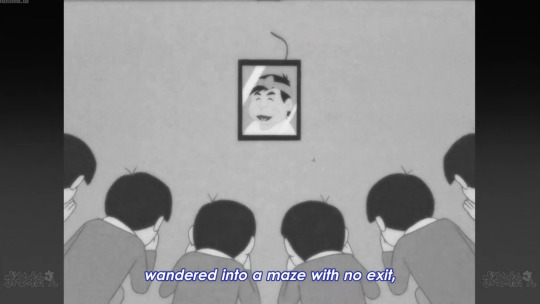
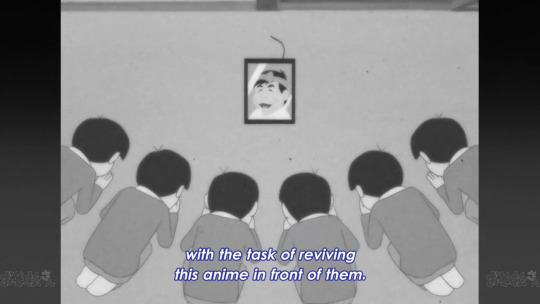
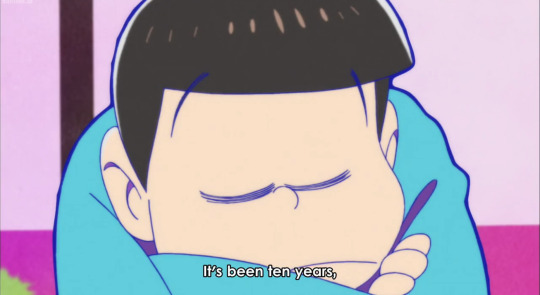
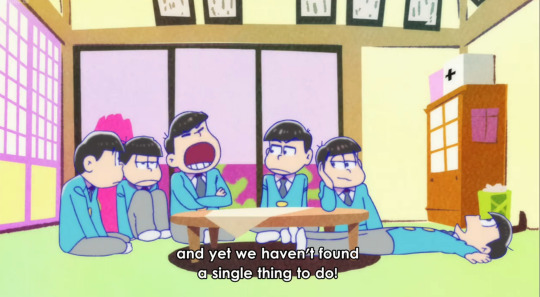
Right off the bat S1E1 makes it clear what to expect: Nothing. Not a damn thing. But, the show had already been cleared for this first season, so it has to be produced. This same episode’s preview is done by Osomatsu, which I’m just gonna quote instead screenshot because there’s too many.
“...we plan on properly starting the anime the next episode.” “...you ended up with an extra minute, so you need me to do something to fill it?! Actually, is this anime going to be okay with episode one being like this? I’m getting worried about how the rest of this is going to be...” “There, I used up a minute! [EPISODE ENDS]”
Episode one is not only batshit referential, but downright mocking the state of anime in 2015. Which, truthfully, I don’t have much to comment on in that regard, as I’m not an avid anime fan. However, it does this under the premise of being indecisive about what kind of anime they wanted the Osokun reboot to be.
They’ll do just about anything to stay popular and relevant considering that is, quite literally, all they have going for them as characters in the series and just being characters in general. They may be pieces of shit, but they’re likeable pieces of shit. The dynamics they’ve built upon to be entertaining is encouraged, and they’re basically just roleplaying different skits and fucking around.
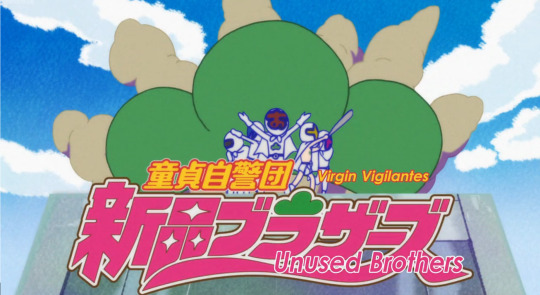

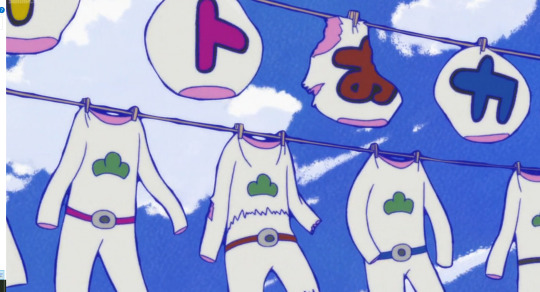
All the AUs! All the skits! They’re just playing! They’re just fuckin’ around!! They couldn’t come up with any interesting plot nor could they “graduate” from being anime protagonists and join the real world, so they just fuck around and make a gag anime!
Even if we follow both as the audience, the show makes a difference between the what’s them in their “normal life” (crazy begets crazy, no?) and what’s their “show.” But, really, that’s just one way to look at it, as they don’t really follow any rules as a show. I could say the Joshimatsus are separate characters from the sextuplets, and it’d be a “correct” interpretation. It doesn’t really matter - I’m choosing to examine it all as being the six of them just running around and playing, because being entertaining and having fun is all they know as characters. Besides, having it blended together beyond recognition reinforces how it prioritizes entertaining us, the audience, above logic. Storytelling doesn’t need to make absolute spatial-temporal sense for it to be enjoyable to fans.
In any case, that mentality really seems to be what pushes their character development negative, as they look to reinforce habits and rituals despite them being really detrimental for them in the long run. They know they’re popular characters as is, and with really everyone from staff to fans encouraging this behavior further, so they see no point in fixing what isn’t really broken.
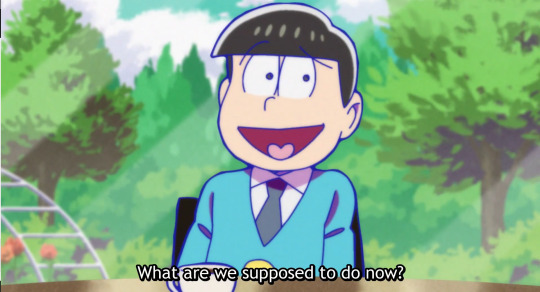

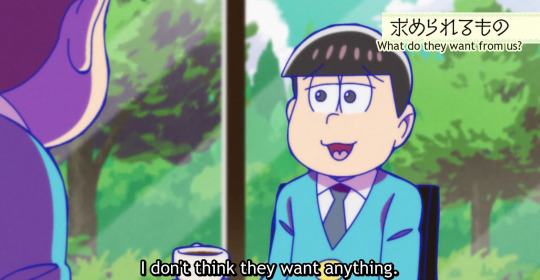
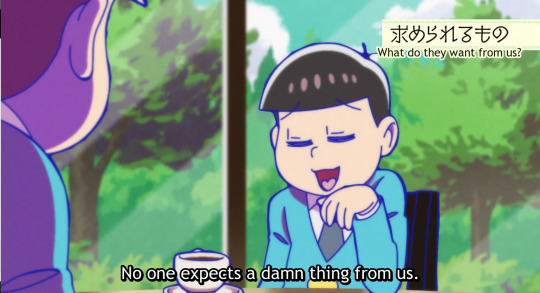
I found this 4 year old article from Manga.Tokyo discussing the Ososan phenomenon in Japan because while the craze died off pretty quickly in American anime circles (which deserves a whole other post), Japanese fans went fuckin’ nuts.
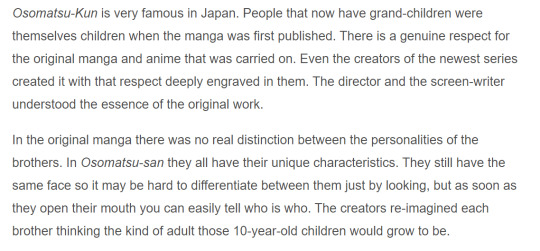
This portion caught my attention, as it makes sense that entitled and enabled asshole children would grow up to be entitled and enabled asshole adults. The article also goes on to compare them to idols (even beyond the F6 spoof) and that they are rooted in being comfort characters above all else.
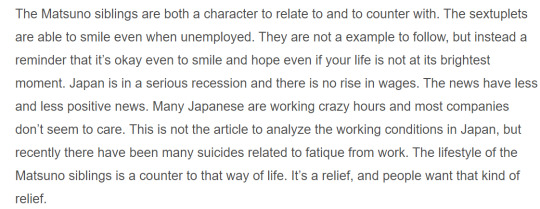
It’s worth a read, especially because Japanese fan response is what drives majority of the content post-S1, and, inevitably, ties into their character development.
They know that they’re Characters, particularly Protagonists. You know what happens to protagonists? Everything works out. Just about every single story created has stuff working out for protagonists. In fact, we have a whole genre made that separates stories with bad tragic endings from our Normal Stories. Ososan is a comedy, not a tragedy, so surely there’s gonna be some payoff somewhere along the road, especially as the seasons and other content are still being pumped out. To a self-aware, entitled, enabled protagonist, assuming everything is just gonna work out for you isn’t that far off from your narrative truth.
However, Ososan is a gag anime, and a lot of gag content (like 4koma mangas) is dropped for other projects before any emotional cathartic ending is provided for characters and fans alike. So, three seasons and a movie later, nothing has happened. It’s a great idol cash cow with a Family Guy filter, and the characters (and writers) don’t even bother to hide it anymore. And I know I’m being hypocritical concerning my definition of “canon material” but I think this portion from one of the drama cds “Choroplex” basically summarizes my point:
CHOROMATSU: Wait, don’t make this into a gag! You don’t even care about becoming employed, right? KARAMATSU: There’s no way that could happen... CHOROMATSU: What kind of future are you imagining? Is it nothing but this? [HUGE PAUSE BEFORE THEY MOVE ONTO SOMETHING ELSE]
They’re parodies of themselves and are running out of ideas. Stagnation and decay is normal, if not unavoidable, at this point in time for them. They’re just 20 somethings who’ve hit a wall but they’re too scared and insecure to bring about permanent positive change. It’s easier for them to fall back into normal patterns and joke off the rest.
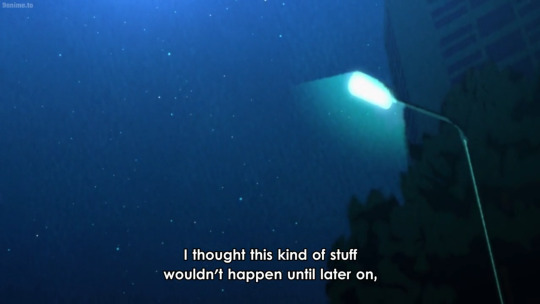
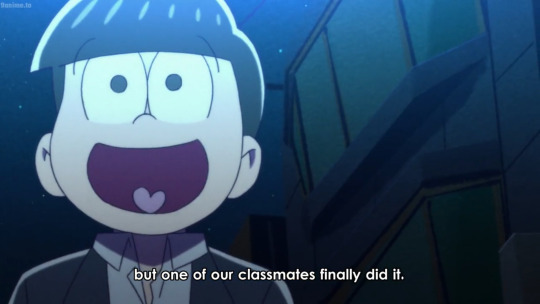
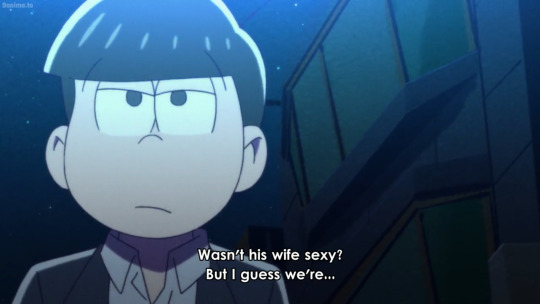
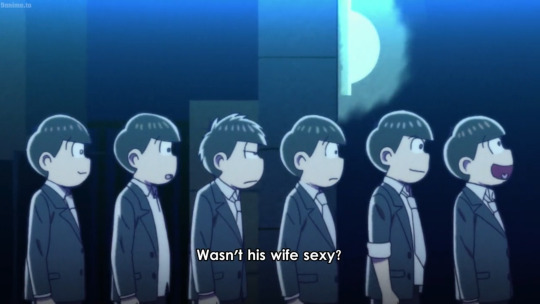
They have an antagonistic relationship with expectations. They can’t handle a single iota of expectations, or responsibilities. They’ve never needed to worry before, so why bother now? Once the biggest hits on the block, now they’re just guppies in the ocean, and there’s nothing they believe themselves to be able to accomplish to keep up with this big brave new world. This is epitomized in S3E15, where old man Osomatsu tells a bastardized version of the Tortoise and the Hare, blatantly projecting his feelings onto it. Again, too many screenshots so let me pull more quotes (bolding for my own reference):
“The place that the tortoise thought was the goal was not actually the goal. His journey down the road of life still continued on. The tortoise was quite tired, but he continued running anyway.” “No one actually knew who was in front anymore. There are too many people above you.” “After the tortoise found out how society worked, he thought, ‘So this is the difference in talent? No amount of hard work is going to fix this. All right. I’m done competing with others.’”
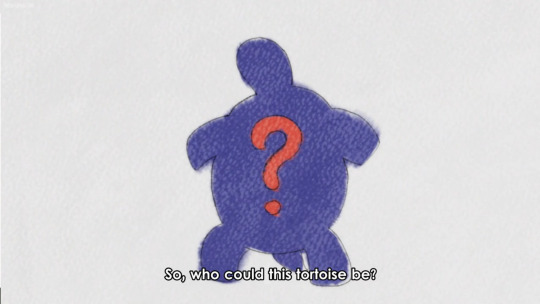
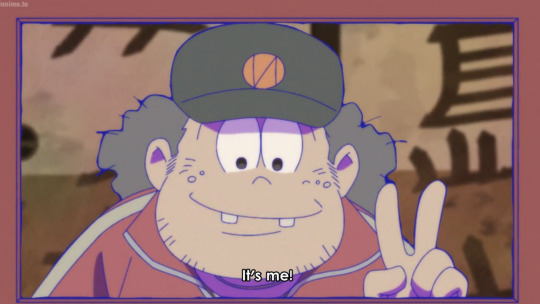
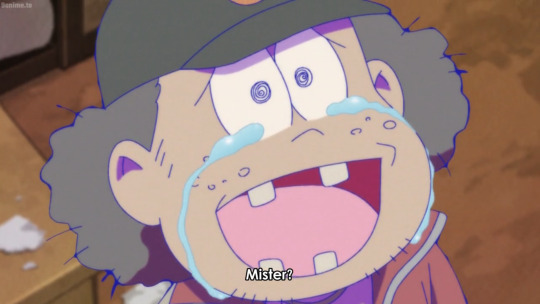
S3 has left more questionable endings than its counterparts. The last 2 skits I referenced don’t even a gag to them, and the marriage skit doesn’t play music for the entire second half of S3E5. There’s more involved too. I haven’t even brought up the rice ball twins becoming actual entertainers in their universe, or how they introduced this whole AI subplot only to reject it because All Six Of Them aren’t interested in expanding their little corner of the world. Here’s a transcript of the ending preview from S3E1:
“Hey, hey, Osomatsu here. I thought we were saved from being replaced, but I guess we get new characters next week. Man, we’re busy. New encounters, changing surroundings... We’re NEETs to begin with because all that is a pain. I guess a lot can happen after three seasons. [EPISODE ENDS]”
The sextuplets’ mindsets are extremely self-centered, which is also an environmental thing (the parents don’t even really care that they’re NEETs, for one) and an understanding of what they ought to be (epic successful protagonists). They also have a very black and white mentality, all or nothing. They’re extremely sheltered, and once they realized where they stood in society at large, they just gave up. To them the world is divided between winners and losers, and somehow, “inexplicably,” they found themselves to have fallen from grace. But they’re protagonists, that has to count for something! Everything’s gonna end up okay, right? Well... what this show has told them: No, not at all. They are consistently compared and warned of Iyami, and are perfectly aware of this fact, and have come to internalize it as a truth rather than a reversible self-fulfilling prophecy.
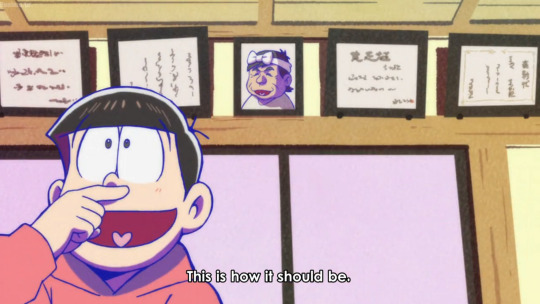
Too many screencaps, taken from the S3S5 marriage discussion:
JYUSHIMATSU: I wonder if we’re gonna get married someday, too. CHOROMATSU: Well, I mean... probably? I’m not exactly sure, but... TODOMATSU: What? You’re gonna get married, Choromatsu-niisan? CHOROMATSU: Huh? Well, yeah... someday.
Surprise! They have commitment issues! The same group that couldn’t commit to a fucking plot! Though their personality issues have several factors involved, I can’t overlook the theater motifs abound. Life’s a stage, and they’re performing entirely unscripted and it shows.
Do I think all of this is 100% intentional on the writers’ part? No, probably not. There’s also an extra layer here regarding contemporary Japanese commentary that I’m not familiar with, so I just ended up focusing on the characters. I can’t be in the writers’ heads, but whatever decisions are being made by executives regarding censorship and “compliance” are reflected in these character changes that result in being significantly more bitter and defeatist.
In the all or nothing, winner-take-all mentality, the only way to save face at this point, in their minds, is to own up to it - act like it’s what they wanted all along. And, hey, it’s funny to watch, right?
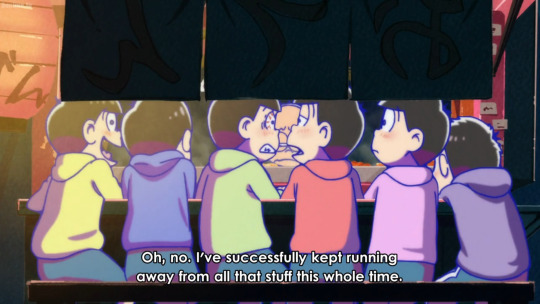
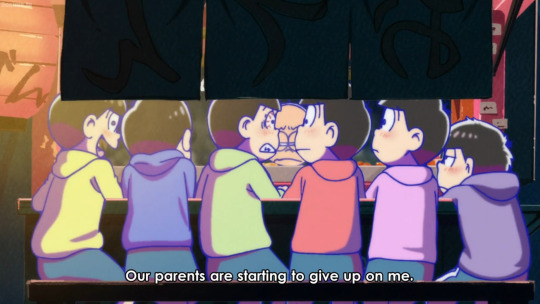
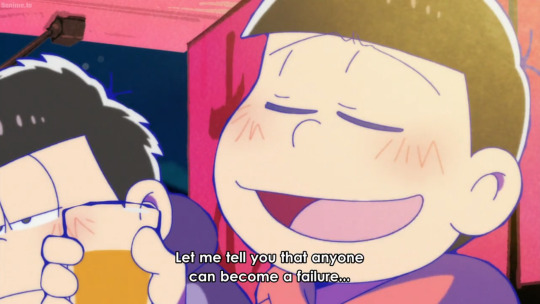
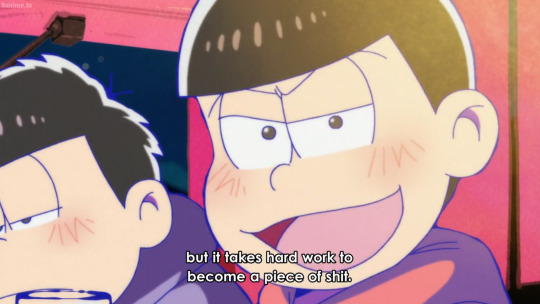
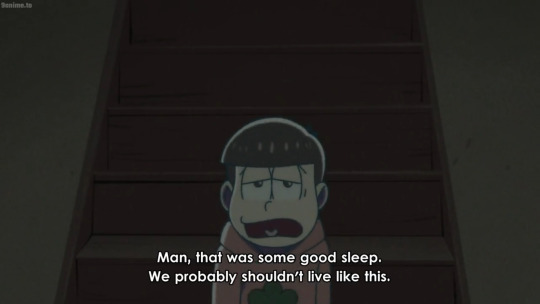
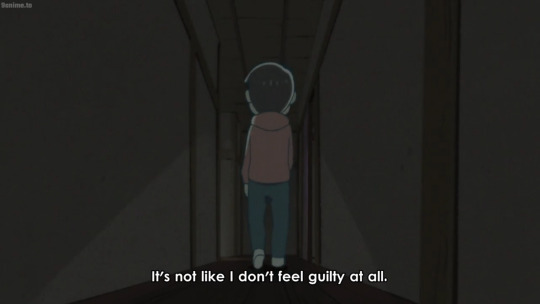
“Why is Osomatsu all my examples”, you might be asking. Well, he’s the damn blueprint for it all. The leader of the bunch, the first personality to grab your attention, has had all his issues projected and ricocheted in their echo chamber.
Ultimately, my point here is that you could think their “canon characterizations” (though canon means nothing in a show like this) as being intertwined with the nature of their self-aware existence. They’ve shown you all their tricks, the smoke and mirrors are getting boring, and they’re stalling long enough the story seems to be moving on without them - in spite of them. And when something genuinely threatens their way of life, they don’t know how to respond.

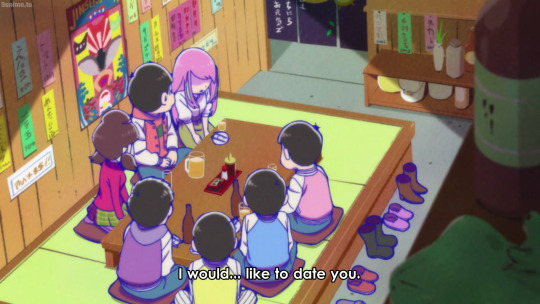

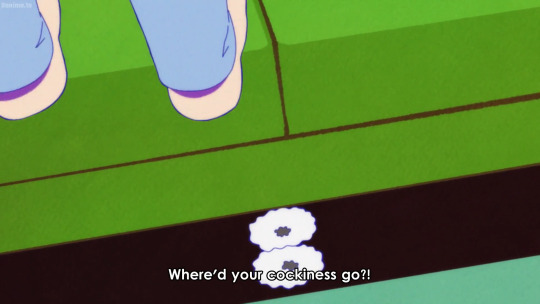
You can play it all straight, of course. Remove the meta jokes and all the same plot points can be hit, but, as a slapstick comedy, it’s able to easily add this additional layer in that I appreciate. I’ve said it in my last post and I’ll probably say it in more, but with comedy comes sincerity - the caveat of all the cartoon violence is that, on some level somewhere, this is how they really feel.
#osomatsu san#osomatsu#karamatsu#choromatsu#ichimatsu#jyushimatsu#todomatsu#osomatsu matsuno#karamatsu matsuno#choromatsu matsuno#ichimatsu matsuno#jyushimatsu matsuno#todomatsu matsuno#analysis#confession this was sparked by a convo i had w friends about s3e18#this is a bit truncated but i couldnt bring myself to make this longer#maybe ill make a pt2 or whatever idk
115 notes
·
View notes
Text
2020 in Movies - My Top 30 Fave Movies (Part 2)

20. ONWARD – Disney and Pixar’s best digitally animated family feature of 2020 (beating the admittedly impressive Soul to the punch) clearly has a love of fantasy roleplay games like Dungeons & Dragons, its quirky modern-day AU take populated by fantastical races and creatures seemingly tailor-made for the geek crowd … needless to say, me and many of my friends absolutely loved it. That doesn’t mean that the classic Disney ideals of love, family and believing in yourself have been side-lined in favour of fan-service – this is as heartfelt, affecting and tearful as their previous standouts, albeit with plenty of literal magic added to the metaphorical kind. The central premise is a clever one – once upon a time, magic was commonplace, but over the years technology came along to make life easier, so that in the present day the various races (elves, centaurs, fauns, pixies, goblins and trolls among others) get along fine without it. Then timid elf Ian Lightfoot (Tom Holland) receives a wizard’s staff for his sixteenth birthday, a bequeathed gift from his father, who died before he was born, with instructions for a spell that could bring him back to life for one whole day. Encouraged by his brash, over-confident wannabe adventurer elder brother Barley (Chris Pratt), Ian tries it out, only for the spell to backfire, leaving them with the animated bottom half of their father and just 24 hours to find a means to restore the rest of him before time runs out. Cue an “epic quest” … needless to say, this is another top-notch offering from the original masters of the craft, a fun, affecting and thoroughly infectious family-friendly romp with a winning sense of humour and inspired, flawless world-building. Holland and Pratt are both fantastic, their instantly believable, ill-at-ease little/big brother chemistry effortlessly driving the story through its ingenious paces, and the ensuing emotional fireworks are hilarious and heart-breaking in equal measure, while there’s typically excellent support from Julia Louis-Dreyfus (Elaine from Seinfeld) as Ian and Barley’s put-upon but supportive mum, Laurel, Octavia Spencer as once-mighty adventurer-turned-restaurateur “Corey” the Manticore and Mel Rodriguez (Getting On, The Last Man On Earth) as overbearing centaur cop (and Laurel’s new boyfriend) Colt Bronco. The film marks the sophomore feature gig for Dan Scanlon, who debuted with 2013’s sequel Monsters University, and while that was enjoyable enough I ultimately found it non-essential – no such verdict can be levelled against THIS film, the writer-director delivering magnificently in all categories, while the animation team have outdone themselves in every scene, from the exquisite environments and character/creature designs to some fantastic (and frequently delightfully bonkers) set-pieces, while there’s a veritable riot of brilliant RPG in-jokes to delight geekier viewers (gelatinous cube! XD). Massive, unadulterated fun, frequently hilarious and absolutely BURSTING with Disney’s trademark heart, this was ALMOST my animated feature of the year. More on that later …
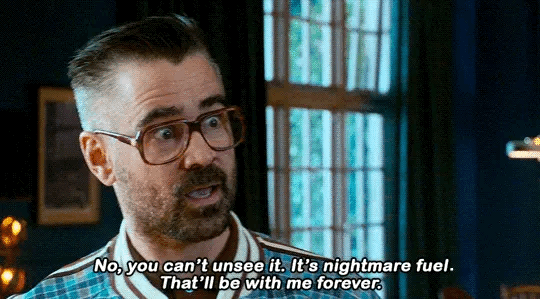
19. THE GENTLEMEN – Guy Ritchie’s been having a rough time with his last few movies (The Man From UNCLE didn’t do too bad but it wasn’t exactly a hit and was largely overlooked or simply ignored, while intended franchise-starter King Arthur: Legend of the Sword was largely derided and suffered badly on release, dying a quick death financially – it’s a shame on both counts, because I really liked them), so it’s nice to see him having some proper success with his latest, even if he has basically reverted to type to do it. Still, when his newest London gangster flick is THIS GOOD it seems churlish to quibble – this really is what he does best, bringing together a collection of colourful geezers and shaking up their status quo, then standing back and letting us enjoy the bloody, expletive-riddled results. This particularly motley crew is another winning selection, led by Matthew McConaughey as ruthlessly successful cannabis baron Mickey Pearson, who’s looking to retire from the game by selling off his massive and highly lucrative enterprise for a most tidy sum (some $400,000,000 to be precise) to up-and-coming fellow American ex-pat Matthew Berger (Succession’s Jeremy Strong, oozing sleazy charm), only for local Chinese triad Dry Eye (Crazy Rich Asians’ Henry Golding, chewing the scenery with enthusiasm) to start throwing spanners into the works with the intention of nabbing the deal for himself for a significant discount. Needless to say Mickey’s not about to let that happen … McConaughey is ON FIRE here, the best he’s been since Dallas Buyers Club in my opinion, clearly having great fun sinking his teeth into this rich character and Ritchie’s typically sparkling, razor-witted dialogue, and he’s ably supported by a quality ensemble cast, particularly co-star Charlie Hunnam as Mickey’s ice-cold, steel-nerved right-hand-man Raymond Smith, Downton Abbey’s Michelle Dockery as his classy, strong-willed wife Rosalind, Colin Farrell as a wise-cracking, quietly exasperated MMA trainer and small-time hood simply known as the Coach (who gets many of the film’s best lines), and, most notably, Hugh Grant as the film’s nominal narrator, thoroughly morally bankrupt private investigator Fletcher, who consistently steals the film. This is Guy Ritchie at his very best – a twisty rug-puller of a plot that constantly leaves you guessing, brilliantly observed and richly drawn characters you can’t help loving in spite of the fact there’s not a single hero among them, a deliciously unapologetic, politically incorrect sense of humour and a killer soundtrack. Getting the cinematic year off to a phenomenal start, it’s EASILY Ritchie’s best film since Sherlock Holmes, and a strong call-back to the heady days of Snatch (STILL my favourite) and Lock, Stock & Two Smoking Barrels. Here’s hoping he’s on a roll again, eh?
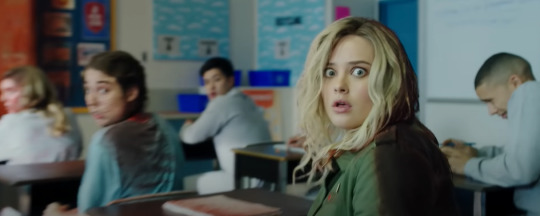
18. SPONTANEOUS – one of the year’s biggest under-the-radar surprise hits for me was one which I actually might not have caught if things had been a little more normal and ordered. Thankfully with all the lockdown and cinematic shutdown bollocks going on, this fantastically subversive and deeply satirical indie teen comedy horror came along at the perfect time, and I completely flipped out over it. Now those who know me know I don’t tend to gravitate towards teen cinema, but like all those other exceptions I’ve loved over the years, this one had a brilliantly compulsive hook I just couldn’t turn down – small-town high-schooler Mara (Knives Out and Netflix’ Cursed’s Katherine Langford) is your typical cool outsider kid, smart, snarky and just putting up with the scene until she can graduate and get as far away as possible … until one day in her senior year one of her classmates just inexplicably explodes. Like her peers, she’s shocked and she mourns, then starts to move on … until it happens again. As the death toll among the senior class begins to mount, it becomes clear something weird is going on, but Mara has other things on her mind because the crisis has, for her, had an unexpected benefit – without it she wouldn’t have fallen in love with like-minded oddball new kid Dylan (Lean On Pete and Words On Bathroom Walls’ Charlie Plummer). The future’s looking bright, but only if they can both live to see it … this is a wickedly intelligent film, powered by a skilfully executed script and a wonderfully likeable young cast who consistently steer their characters around the potential cliched pitfalls of this kind of cinema, while debuting writer-director Brian Duffield (already a rising star thanks to scripts for Underwater, The Babysitter and blacklist darling Jane Got a Gun among others) show he’s got as much talent and flair for crafting truly inspired cinema as he has for thinking it up in the first place, delivering some impressively offbeat set-pieces and several neat twists you frequently don’t see coming ahead of time. Langford and Plummer as a sassy, spicy pair who are easy to root for without ever getting cloying or sweet, while there’s glowing support from the likes of Hayley Law (Rioverdale, Altered Carbon, The New Romantic) as Mara’s best friend Tess, Piper Perabo and Transparent’s Rob Huebel as her increasingly concerned parents, and Insecure’s Yvonne Orji as Agent Rosetti, the beleaguered government employee sent to spearhead the investigation into exactly what’s happening to these kids. Quirky, offbeat and endlessly inventive, this is one of those interesting instances where I’m glad they pushed the horror elements into the background so we could concentrate on the comedy, but more importantly these wonderfully well-realised and vital characters – there are some skilfully executed shocks, but far more deep belly laughs, and there’s bucketloads of heart to eclipse the gore. Another winning debut from a talent I intend to watch with great interest in the future.

17. HAMILTON – arriving just as Black Lives Matter reached fever-pitch levels, this feature presentation of the runaway Broadway musical smash-hit could not have been better timed. Shot over three nights during the show’s 2016 run with the original cast and cut together with specially created “setup shots”, it’s an immersive experience that at once puts you right in amongst the audience (at times almost a character themselves, never seen but DEFINITELY heard) but also lets you experience the action up close. And what action – it’s an incredible show, a thoroughly fascinating piece of work that reads like something very staid and proper on paper (an all-encompassing biographical account of the life and times of American Founding Father Alexander Hamilton) but, in execution, becomes something very different and EXTREMELY vital. The execution certainly couldn’t be further from the usual period biopic fare this kind of historical subject matter usually gets (although in the face of recent high quality revisionist takes like Marie Antoinette, The Great and Tesla it’s not SO surprising), while the cast is not at all what you’d expect – with very few notable exceptions the cast is almost entirely people of colour, despite the fact that the real life individuals they’re playing were all very white indeed. Every single one of them is also an absolute revelation – the show’s writer-composer Lin-Manuel Miranda (already riding high on the success of In the Heights) carries the central role of Hamilton with effortless charm and raw star power, Leslie Odom Jr. (Smash, Murder On the Orient Express) is duplicitously complex as his constant nemesis Aaron Burr, Christopher Jackson (In the Heights, Moana, Bull) oozes integrity and nobility as his mentor and friend George Washington, Phillipa Soo is sweet and classy as his wife Eliza while Renée Elise Goldsberry (The Immortal Life of Henrietta Jacks, Altered Carbon) is fiery and statuesque as her sister Angelica Schuyler (the one who got away), and Jonathan Groff (Mindhunter) consistently steals every scene he’s in as fiendish yet childish fan favourite King George III, but the show (and the film) ultimately belongs to veritable powerhouse Daveed Diggs (Blindspotting, The Good Lord Bird) in a spectacular duel role, starting subtly but gaining scene-stealing momentum as French Revolutionary Gilbert du Motier, the Marquis de Lafayette, before EXPLODING onto the stage in the second half as indomitable third American President Thomas Jefferson. Not having seen the stage show, I was taken completely by surprise by this, revelling in its revisionist genius and offbeat, quirky hip-hop charm, spellbound by the skilful ease with which is takes the sometimes quite dull historical fact and skews it into something consistently entertaining and absorbing, transported by the catchy earworm musical numbers and thoroughly tickled by the delightfully cheeky sense of humour strung throughout (at least when I wasn’t having my heart broken by moments of raw dramatic power). Altogether it’s a pretty unique cinematic experience I wish I could have actually gotten to see on the big screen, and one I’ve consistently recommended to all my friends, even the ones who don’t usually like musicals. As far as I’m concerned it doesn’t need a proper Les Misérables style screen adaptation – this is about as perfect a presentation as the show could possibly hope for.
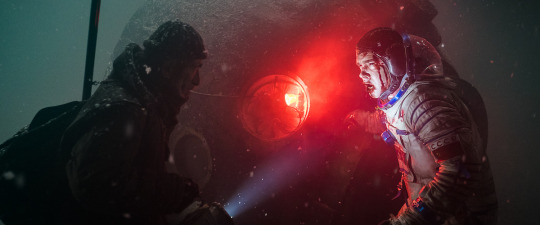
16. SPUTNIK – summer’s horror highlight (despite SERIOUSLY tough competition) was a guaranteed sleeper hit that I almost missed entirely, stumbling across the trailer one day on YouTube and getting bowled over by its potential, prompting me to hunt it down by any means necessary. The feature debut of Russian director Egor Abramenko, this first contact sci-fi chiller is about as far from E.T. as it’s possible to get, sharing some of the same DNA as Carpenter’s The Thing but proudly carving its own path with consummate skill and definitely signalling great things to come from its brand new helmer and relative unknown screenwriters Oleg Malovichko and Andrei Zolotarev. Oksana Akinshina (probably best known in the West for her powerful climactic cameo in The Bourne Supremacy) is the beating heart of the film as neurophysiologist Tatyana Yuryevna Klimova, brought in to aid in the investigation in the Russian wilderness circa 1983 after an orbital research mission goes horribly wrong. One of the cosmonauts dies horribly, while the other, Konstantin (The Duelist’s Pyotr Fyodorov) seems unharmed, but it quickly becomes clear that he’s now the host for something decidedly extraterrestrial and potentially terrifying, and as Tatyana becomes more deeply embroiled in her assignment she comes to realise that her superiors, particularly mysterious Red Army project leader Colonel Semiradov (The PyraMMMid’s Fyodor Bondarchuk), have far more insidious plans for Konstantin and his new “friend” than she could ever imagine. This is about as dark, intense and nightmarish as this particular sub-genre gets, a magnificently icky body horror that slowly builds its tension as we’re gradually exposed to the various truths and the awful gravity of the situation slowly reveals itself, punctuated by skilfully executed shocks and some particularly horrifying moments when the evils inflicted by the humans in charge prove far worse than anything the alien can do, while the ridiculously talented writers have a field day pulling the rug out from under us again and again, never going for the obvious twist and keeping us guessing right to the devastating ending, while the beautifully crafted digital creature effects are nothing short of astonishing and thoroughly creepy. Akinshina dominates the film with her unbridled grace, vulnerability and integrity, the relationship that develops between Tatyana and Konstantin (Fyodorov delivering a beautifully understated turn belying deep inner turmoil) feeling realistically earned as it goes from tentatively wary to tragically bittersweet, while Bondarchuk invests the Colonel with a nuanced air of tarnished authority and restrained brutality that made him one of my top screen villains for the year. One of 2020’s great sleeper hits, I can’t speak of this film highly enough – it’s a genuine revelation, an instant classic for whom I’ll sing its praises for years to come, and I wish enormous future success to all the creative talents involved.

15. THE INVISIBLE MAN – looks like third time’s a charm for Leigh Whannell, writer-director of my ALMOST horror movie of the year (more on that later) – while he’s had immense success as a horror writer over the years (co-creator of both the Saw and Insidious franchises), as a director his first two features haven’t exactly set the world alight, with debut Insidious: Chapter III garnering similar takes to the rest of the series but ultimately turning out to be a bit of a damp squib quality-wise, while his second feature Upgrade was a stone-cold masterpiece that was (rightly) EXTREMELY well received critically, but ultimately snuck in under the radar and has remained a stubbornly hidden gem since. No such problems with his third feature, though – his latest collaboration with producer Jason Blum and the insanely lucrative Blumhouse Pictures has proven a massive hit both financially AND with reviewers, and deservedly so. Having given up on trying to create a shared cinematic universe inhabited by their classic monsters, Universal resolved to concentrate on standalones to showcase their elite properties, and their first try is a rousing success, Whannell bringing HG Wells’ dark and devious human monster smack into the 21st Century as only he can. The result is a surprisingly subtle piece of work, much more a lethally precise exercise in cinematic sleight of hand and extraordinary acting than flashy visual effects, strictly adhering to the Blumhouse credo of maximum returns for minimum bucks as the story is stripped down to its bare essentials and allowed to play out without any unnecessary weight. The Handmaid’s Tale’s Elizabeth Moss once again confirms what a masterful actress she is as she brings all her performing weapons to bear in the role of Cecelia “Cee” Kass, the cloistered wife of affluent but monstrously abusive optics pioneer Aidan Griffin (Netflix’ The Haunting of Hill House’s Oliver Jackson-Cohen), who escapes his clutches in the furiously tense opening sequence and goes to ground with the help of her closest childhood friend, San Francisco cop James Lanier (Leverage’s Aldis Hodge) and his teenage daughter Sydney (A Wrinkle in Time’s Storm Reid). Two weeks later, Aidan commits suicide, leaving Cee with a fortune to start her life over (with the proviso that she’s never ruled mentally incompetent), but as she tries to find her way in the world again little things start going wrong for her, and she begins to question if there might be something insidious going on. As her nerves start to unravel, she begins to suspect that Aidan is still alive, still very much in her life, fiendishly toying with her and her friends, but no-one can see him. Whannell plays her paranoia up for all it’s worth, skilfully teasing out the scares so that, just like her friends, we begin to wonder if it might all be in her head after all, before a spectacular mid-movie reveal throws the switch into high gear and the true threat becomes clear. The lion’s share of the film’s immense success must of course go to Moss – her performance is BEYOND a revelation, a blistering career best that totally powers the whole enterprise, and it goes without saying that she’s the best thing in this. Even so, she has sterling support from Hodge and Reid, as well as Love Child’s Harriet Dyer as Cee’s estranged big sister Emily and Wonderland’s Michael Dorman as Adrian’s slimy, spineless lawyer brother Tom, and, while he doesn’t have much actual (ahem) “screen time”, Jackson-Cohen delivers a fantastically icy, subtly malevolent turn which casts a large “shadow” over the film. This is one of my very favourite Blumhouse films, a pitch-perfect psychological chiller that keeps the tension cranked up unbearably tight and never lets go, Whannell once again displaying uncanny skill with expert jump-scares, knuckle-whitening chills and a truly astounding standout set-piece that easily goes down as one of the top action sequences of 2020. Undoubtedly the best version of Wells’ story to date, this goes a long way in repairing the damage of Universal’s abortive “Dark Universe” efforts, as well as showcasing a filmmaking master at the very height of his talents.
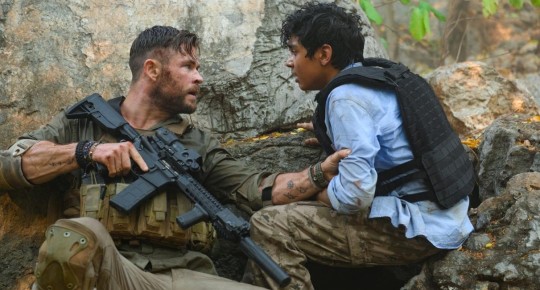
14. EXTRACTION – the Coronavirus certainly has threw a massive spanner in the works of the year’s cinematic calendar – among many other casualties to the blockbuster shunt, the latest (and most long-awaited) MCU movie, Black Widow, should have opened to further record-breaking box office success at the end of spring, but instead the theatres were all closed and virtually all the heavyweights were pushed back or shelved indefinitely. Thank God, then, for the streaming services, particularly Hulu, Amazon and Netflix, the latter of which provided a perfect movie for us to see through the key transition into the summer blockbuster season, an explosively flashy big budget action thriller ushered in by MCU alumni the Russo Brothers (who produced and co-wrote this adaptation of Ciudad, a graphic novel that Joe Russo co-created with Ande Parks and Fernando Leon Gonzalez) and barely able to contain the sheer star-power wattage of its lead, Thor himself. Chris Hemsworth plays Tyler Rake, a former Australian SAS operative who hires out his services to an extraction operation under the command of mercenary Nik Khan (The Patience Stone’s Golshifteh Farahani), brought in to liberate Ovi Mahajan (Rudhraksh Jaiswal in his first major role), the pre-teen son of incarcerated Indian crime lord Ovi Sr. (Pankaj Tripathi), who has been abducted by Bangladeshi rival Amir Asif (Priyanshu Painyuli). The rescue itself goes perfectly, but when the time comes for the hand-off the team is double-crossed and Tyler is left stranded in the middle of Dhaka with no choice but to keep Ovi alive as every corrupt cop and street gang in the city closes in around them. This is the feature debut of Sam Hargrave, the latest stuntman to try his hand at directing, so he certainly knows his way around an action set-piece, and the result is a thoroughly breathless adrenaline rush of a film, bursting at the seams with spectacular fights, gun battles and car chases, dominated by a stunning sustained sequence that plays out in one long shot, guaranteed to leave jaws lying on the floor. Not that there should be any surprise – Hargrave cut his teeth as a stunt coordinator for the Russos on Captain America: Civil War and their Avengers films. That said, he displays strong talent for the quieter disciplines of filmmaking too, delivering quality character development and drawing out consistently noteworthy performances from his cast. Of course, Hemsworth can do the action stuff in his sleep, but there’s a lot more to Tyler than just his muscle, the MCU veteran investing him with real wounded vulnerability and a tragic fatalism which colours every scene, while Jaiswal is exceptional throughout, showing plenty of promise for the future, and there’s strong support from Farahani and Painyuli, as well as Stranger Things’ David Harbour as world-weary retired merc Gaspard, and a particularly impressive, muscular turn from Randeep Hooda (Once Upon a Time in Mumbai) as Saju, a former Para and Ovi’s bodyguard, who’s determined to take possession of the boy himself, even if he has to go through Tyler to get him. This is action cinema that really deserves to be seen on the big screen – I watched it twice in a week and would happily have paid for two trips to the cinema for it if I could have. As we looked down the barrel of a summer season largely devoid of blockbuster fare, I couldn’t recommend this enough. Thank the gods for Netflix …
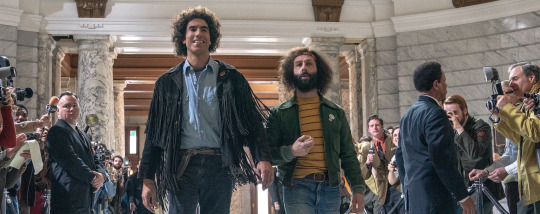
13. THE TRIAL OF THE CHICAGO 7 – although it’s definitely a film that really benefitted enormously from releasing on Netflix during the various lockdowns, this was one of the blessed few I actually got to see during one of the UK’s frustratingly rare lulls when cinemas were actually OPEN. Rather perversely it therefore became one of my favourite cinematic experiences of 2020, but then I’m just as much a fan of well-made cerebral films as I am of the big, immersive blockbuster EXPERIENCES, so this probably still would have been a standout in a normal year. Certainly if this was a purely CRITICAL list for the year this probably would have placed high in the Top Ten … Aaron Sorkin is a writer whose work I have ardently admired ever since he went from esteemed playwright to in-demand talent for both the big screen AND the small with A Few Good Men, and TTOTC7 is just another in a long line of consistently impressive, flawlessly written works rife with addictive quickfire dialogue, beautifully observed characters and rewardingly propulsive narrative storytelling (therefore resting comfortably amongst the well-respected likes of The West Wing, Charlie Wilson’s War, Moneyball and The Social Network). It also marks his second feature as a director (after fascinating and incendiary debut Molly’s Game), and once again he’s gone for true story over fiction, tackling the still controversial subject of the infamous 1968 trial of the “ringleaders” of the infamous riots which marred Chicago’s Diplomatic National Convention five months earlier, in which thousands of hippies and college students protesting the Vietnam War clashed with police. Spurred on by the newly-instated Presidential Administration of Richard Nixon to make some examples, hungry up-and-coming prosecutor Richard Schultz (Joseph Gordon-Levitt) is confident in his case, while the Seven – who include respected and astute student activist Tom Hayden (Eddie Redmayne) and confrontational counterculture firebrands Abbie Hoffman (Sacha Baron Cohen) and Jerry Rubin (Succession’s Jeremy Strong) – are the clear underdogs. They’re a divided bunch (particularly Hayden and Hoffman, who never mince their words about what little regard they hold for each other), and they’re up against the combined might of the U.S. Government, while all they have on their side is pro-bono lawyer and civil rights activist William Kunstler (Mark Rylance), who’s sharp, driven and thoroughly committed to the cause but clearly massively outmatched … not to mention the fact that the judge presiding over the case is Julius Hoffman (Frank Langella), a fierce and uncompromising conservative who’s clearly 100% on the Administration’s side, and who might in fact be stark raving mad (he also frequently goes to great lengths to make it clear to all concerned that he is NOT related to Abbie). Much as we’ve come to expect from Sorkin, this is cinema of grand ideals and strong characters, not big spectacle and hard action, and all the better for it – he’s proved time and again that he’s one of the very best creative minds in Hollywood when it comes to intelligent, thought-provoking and engrossing thinking-man’s entertainment, and this is pure par for the course, keeping us glued to the screen from the skilfully-executed whirlwind introductory montage to the powerfully cathartic climax, and every varied and brilliant scene in-between. This is heady stuff, focusing on what’s still an extremely thorny issue made all the more urgently relevant and timely given what was (and still is) going on in American politics at the time, and everyone involved here was clearly fully committed to making the film as palpable, powerful and resonant as possible for the viewer, no matter their nationality or political inclination. Also typical for a Sorkin film, the cast are exceptional, everyone clearly having the wildest time getting their teeth into their finely-drawn characters and that magnificent dialogue – Redmayne and Baron Cohen are compellingly complimentary intellectual antagonists given their radically different approaches and their roles’ polar opposite energies, while Rylance delivers another pitch-perfect, simply ASTOUNDING performance that once again marks him as one of the very best actors of his generation, and there are particularly meaty turns from Strong, Langella, Aquaman’s Yahya Abdul-Mateen II (as besieged Black Panther Bobby Seale) and a potent late appearance from Michael Keaton that sear themselves into the memory long after viewing. Altogether then, this is a phenomenal film which deserves to be seen no matter the format, a thought-provoking and undeniably IMPORTANT masterwork from a master cinematic storyteller that says as much about the world we live in now as the decidedly turbulent times it portrays …
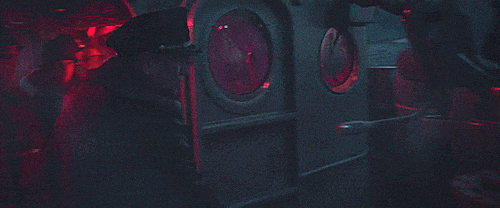
12. GREYHOUND – when the cinemas closed back in March, the fate of many of the major summer blockbusters we’d been looking forward to was thrown into terrible doubt. Some were pushed back to more amenable dates in the autumn or winter (which even then ultimately proved frustratingly ambitious), others knocked back a whole year to fill summer slots for 2021, but more than a few simply dropped off the radar entirely with the terrible words “postponed until further notice” stamped on them, and I lamented them all, this one in particular. It hung in there longer than some, stubbornly holding onto its June release slot for as long as possible, but eventually it gave up the ghost too … but thanks to Apple TV+, not for long, ultimately releasing less than a month later than intended. Thankfully the film itself was worth the fuss, a taut World War II suspense thriller that’s all killer, no filler – set during the infamous Battle of the Atlantic, it portrays the constant life-or-death struggle faced by the Allied warships assigned to escort the transport convoys as they crossed the ocean, defending their charges from German U-boats. Adapted from C.S. Forester’s famous 1955 novel The Good Shepherd by Tom Hanks and directed by Aaron Schneider (Get Low), the narrative focuses on the crew of the escort leader, American destroyer USS Fletcher, codenamed “Greyhound”, and in particular its captain, Commander Ernest Krause (Hanks), a career sailor serving his first command. As they cross “the Pit”, the most dangerous middle stretch of the journey where they spend days without air-cover, they find themselves shadowed by “the Wolf Pack”, a particularly cunning group of German submarines that begin to pick away at the convoy’s stragglers. Faced with daunting odds, a dwindling supply of vital depth-charges and a ruthless, persistent enemy, Krause must make hard choices to bring his ships home safe … jumping into the thick of the action within the first ten minutes and maintaining its tension for the remainder of the trim 90-minute run, this is screen suspense par excellence, a sleek textbook example of how to craft a compelling big screen knuckle-whitener with zero fat and maximum reward, delivering a series of desperate naval scraps packed with hide-and-seek intensity, heart-in-mouth near-misses and fist-in-air cathartic payoffs by the bucket-load. Hanks is subtly magnificent, the calm centre of the narrative storm as a supposed newcomer to this battle arena who could have been BORN for it, bringing to mind his similarly unflappable in Captain Phillips and certainly not suffering by comparison; by and large he’s the focus point, but other crew members make strong (if sometimes quite brief) impressions, particularly Stephen Graham as Krause’s reliably seasoned XO, Lt. Commander Charlie Cole, The Magnificent Seven’s Manuel Garcia-Rulfo and Just Mercy’s Rob Morgan, while Elisabeth Shue does a lot with a very small part in brief flashbacks as Krause’s fiancée Evelyn. Relentless, exhilarating and thoroughly unforgettable, this was one of the true action highlights of the summer, and one hell of a war flick. I’m so glad it made the cut for the summer …
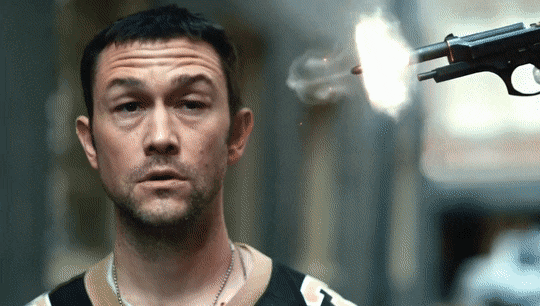
11. PROJECT POWER – with Marvel and DC pushing their tent-pole titles back in the face of COVID, the usual superhero antics we’ve come to expect for the summer were pretty thin on the ground in 2020, leading us to find our geeky fan thrills elsewhere. Unfortunately, pickings were frustratingly slim – Korean comic book actioner Gundala was entertaining but workmanlike, while Thor AU Mortal was underwhelming despite strong direction from Troll Hunter’s André Øvredal, and The New Mutants just got shat on by the studio and its distributors and no mistake – thank the Gods, then, for Netflix, once again riding to the rescue with this enjoyably offbeat super-thriller, which takes an intriguing central premise and really runs with it. New designer drug Power has hit the streets of New Orleans, able to give anyone who takes it a superpower for five minutes … the only problem is, until you try it, you don’t know what your own unique talent is – for some, it could mean five minutes of invisibility, or insane levels of super-strength, but other powers can be potentially lethal, the really unlucky buggers just blowing up on the spot. Robin (The Hate U Give’s Dominique Fishback) is a teenage Power-pusher with dreams of becoming a rap star, dealing the pills so she can help her diabetic mum; Frank Shaver (Joseph Gordon-Levitt) is one of her customers, a police detective who uses his power of near invulnerability to even the playing field when supercharged crims cause a disturbance. Their lives are turned upside down when Art (Jamie Foxx) arrives in town – he’s a seriously badass ex-soldier determined to hunt down the source of Power by any means necessary, and he’s not above tearing the Big Easy apart to do it. This is a fun, gleefully infectious rollercoaster that doesn’t take itself too seriously, revelling in the anarchic potential of its premise and crafting some suitably OTT effects-driven chaos brought to pleasingly visceral fruition by its skilfully inventive director, Ariel Schulman (Catfish, Nerve, Viral), while Mattson Tomlin (the screenwriter of the DCEU’s oft-delayed, incendiary headline act The Batman) takes the story in some very interesting directions and poses fascinating questions about what Power’s TRULY capable of. Gordon-Levitt and Fishback are both brilliant, the latter particularly impressing in what’s sure to be a major breakthrough role for her, and the friendship their characters share is pretty adorable, while Foxx really is a force to be reckoned with, pretty chill even when he’s in deep shit but fully capable of turning into a bona fide killing machine at the flip of a switch, and there’s strong support from Westworld’s Rodrigo Santoro as Biggie, Power’s delightfully oily kingpin, Courtney B. Vance as Frank’s by-the-book superior, Captain Crane, Amy Landecker as Gardner, the morally bankrupt CIA spook responsible for the drug’s production, and Machine Gun Kelly as Newt, a Power dealer whose pyrotechnic “gift” really isn’t all it’s cracked up to be. Exciting, inventive, frequently amusing and infectiously likeable, this was some of the most uncomplicated cinematic fun I had all summer. Not bad for something which I’m sure was originally destined to become one of the season’s B-list features …
#onward#onward movie#The Gentlemen#spontaneous#spontaneous movie#hamilton#hamilton movie#sputnik#sputnik movie#The Invisible Man#Extraction#extraction movie#the trial of the chicago 7#greyhound#greyhound movie#project power#2020 in movies
25 notes
·
View notes
Text
Unorganised thoughts on Trails of Cold Steel I:
So I did like it overall, but I have a lot more criticisms of it than I did of the previous games
Which also means I have way more to say!
Tl;dr - Rean Schwarzer, Estelle Bright you are not
Also, spoiler warning for both this game and the previous ones
So... the pacing in this was weird. Like I loved all the field study segments, they were SO fun, but there’s also the Trista segments between which very boring and felt like filler
I think it’s meant to make the ending feel more important, since you’re defending the school, but it kind of backfired because being forced to run around Thors (which is not a very interestingly designed location, by the way) over and over and over again actually made me kind of resent it. To a point where I low key wanted the ILF to destroy the school. Oops
Like I cared about Liberl and Crossbell because they were interesting, and big, so I never really got tired of them. I got tired of Trista very quickly
Also having everyone in school uniform made their designs less interesting :/
The other places were all super interesting, though! I think if I had to pick a favourite I’d say Bareahard, but they’re all contenders really
Oh also the other issue with the structure was that everyone had to be mad at someone at all times, and it was almost comical how systematic it was - Rean and Alisa don’t get on, that’s resolved, now let’s focus on how Machias and Jusis don’t get on, that’s resolved, IMMEDIATELY we’ll replace that with Fie and Laura, then the moment that’s resolved it’s Jusis and Milliam...
Like, be a little less formulaic in your character conflict
Anyway, characters!
I do not like the thing where the character’s name appears in front of them before they say it. It was irritating
Elliot: The one I would have been in love with when I was eleven. Elliot is good and sweet and did nothing wrong ever. Holy Song is the most useful craft in the whole goddamn game. He also has easily the best S-Craft in a game where most of the S-Crafts are *decidedly* lackluster, aesthetically speaking. I like Elliot. His friendship with Gaius is also very nice
Jusis: The one I would have been in love with when I was fourteen. So, the moment I saw Jusis, my immediate first thought was ‘oh, this guy is one half of a gay ship’. I had no clue who the other guy was going to be, but I knew there was absolutely no way that Anime Draco Malfoy wasn’t getting shipped with a man.
And then Machias opened his mouth, and... every franchise, no matter what, has its gay OTP (its homoTP, if you will) - that one, usually M/M, but sometimes F/F, ship that’s practically got a whole side-fandom just for itself. Up until now, I assumed Trails’ was going to be Olivier/Mueller - but while I haven’t checked, because I don’t want spoilers, I will be shocked if these guys aren’t actually it. They have every making - opposites attract, enemies to lovers, they sing together, other characters make jokes about it...
Like, this was deliberate, surely? Surely?
yes i ship it but like, against my will and resentfully and semi-ironically, because I hate myself for instinctively taking the bait >:(
Something something ‘Turbo-Gehenna’ joke
Anyway, I like Jusis. I think he’s a fun character, easily the most interesting of the boys, and I really enjoyed his development. He has a cute smile
I also thought he had the best voice acting in Class VII, so I looked it up and Ben Diskin! I love Ben Diskin! I couldn’t even tell, I had no idea his range was that great, wow!
I did think it was extremely weird that if you invite him to the Stella Garten, he says he wants to date a woman who is ‘like his mother’. Okay, Jusis.
Machias: The one I would have been in love with when I was seventeen. You ever meet someone who’s like... always right, really, but in such an obnoxious way that you wish they weren’t. Machias. He would have been way more interesting if he was just a really politically minded teen who needed to learn tact, rather than yet another member of the Trails Dead Family Member Club (the fact that it was revealed right after Elliot’s Dead Family Member Club story did not help). Still, he really did grow on me in the end. He’s a little dork
Gaius: The one I would be in love with now, if not for the fact that he’s only seventeen and thus a little baby in my eyes. I do love his design the most. Can he say even one line that’s not about the wind, though? I also like that he’s one of very few characters in this franchise to not have a tragic backstory, was very refreshing.
I can only assume, therefore, that Nord will undergo ethnic cleansing in Cold Steel II
Crow: oh boy Crow hahahahahaha. I don’t know how I feel now. Uhhhh... what did ‘the things I do for love mean’? I am curious
Alisa: I don’t like tsunderes much, and I found her ‘being mad at Rean for something that was absolutely not his fault’ thing very, very stupid and it did not endear me to her at all (also, like, if you had to have that - a better way would have been for him to accidentally injure her, rather than... ugh, look, I am a woman with large breasts - accidents really do happen irl. There’s no point in getting that mad about it. There just isn’t. I have no patience for this kind of plot). It also bothered me how possessive of Rean she got, I swear I picked Towa over her half out of spite. I don’t hate her, though, to be clear - I loved her plot with her mother and that scene in Nord. And her relationship with Ferris! She’s great when she’s not talking about Rean, basically
I don’t buy her as Rean’s love interest, honestly. Rean consistently shows more attraction to Emma, and has more (mandatory/canon) moments with Towa. It only felt one-sided to me
Laura: I like Laura a lot. I don’t really have anything to say about her, just that she was consistently good, and I appreciated her maturity and self awareness, I love her and Rean being sword bros, she’s just great
Fie: I think Fie was designed to appeal to exactly me personally. Tiny snarky badass girl with a great design? That’s everything I love and aspire to be! Best girl in the game (didn’t date her though because she’s fifteen and I refuse to date anyone who is younger than the protagonist when I play games set in high schools. Feels weird enough dating teens the same age as my character. Also she had 0 romantic chemistry with Rean)
Millium: She’s fine, good voice acting, want to know more about Lammy, no strong feelings
Towa: I wasn’t going to date anyone, but changed my mind because I really liked Towa... and then I looked at her, and saw a tiny girl with long, light brown hair and soft voice, and realised I just want to date myself
I checked, and according to Playstation Trophies, at least, she’s the least picked girl? The only characters picked less than her are the non-Crow boys (Machias is the least popular, which... I feel a little mean for finding hilarious lol)
Emma: I like Emma herself just fine. Don’t get me wrong. But she’s infuriating as a mystery character, because she’s the worst kind of mystery - the kind that relies on the other characters to NEVER AT ANY POINT ASK THE QUESTIONS THAT A NORMAL HUMAN WOULD ASK
Estelle would have asked
Rean has multiple opportunities to ask her to explain herself, and he doesn’t! One time, she straight up ASKS HIM TO ASK, and he doesn’t! That’s not mysterious anymore! That’s just incredibly annoying!
Lloyd would have asked
And no one else asks either! Some of them, fine - I can understand say, Elliot or Gaius or Millium - but Jusis!? Jusis, who has been there for pretty much all of her mysterious vague magic, and has repeatedly shown himself to be willing to be kind of rude, and may not be that interested in other people but certainly isn’t stupid - while they’re in the Schoolhouse Depths, Jusis isn’t going to grab Emma by the shoulders and demand she explain what she knows? He’s just going to go with it as she refuses to elaborate on things?
Really?
Kevin would have - actually, no, Kevin would have already known because Kevin Knows All, but he would have told everyone else, so same outcome
Rean: And that brings me to Rean. Rean... is a JRPG Protagonist. He is good, and noble, and he gives Inspiring Speeches, and he can date all the girls (which means we don’t really get any interesting opposite-gender friendships, because oh no, a threat to the harem!), and he is so, so boring. My god
Hey remember how I praised Sky for how great it was to have Estelle be an actual person with flaws and personality? No you don’t, no one’s reading all of these, but yeah - Estelle is just as colourful and full of life as the rest of Sky, while Rean is the least interesting character in Cold Steel no contest
Oh he has a super powered dark side, oh, well, that’s a game changer, never seen that before except in every 2000s shounen anime. Also we never actually learn the Super Rean rules, so that dramatic moment where he’s thinking about transforming to fight Scarlet isn’t actually that dramatic because I had never realised it could kill him until he said so in that moment
Oh except he’s also an awakener and can summon a Persona giant mecha suit! Because he’s the most special boy to be very special? I have never seen that in a JRPG before except in all of them
In Sky, Estelle wasn’t special. Except she was, but it wasn’t because she had super awesome secret awesome powers and all the boys liked her best. It was because she was flawed, but always trying, and because she was incredibly brave and optimistic no matter what, and because she was the kind of person who told a god summoning evil mastermind ‘lol no’ and then beat him with a stick, and because she really, believably loved her friends. She loved them. And they loved her. Not the player she was the avatar of. Estelle herself
Estelle Bright has ruined me for all other JRPG protagonists, is what I’m saying
Oh also Rean has that whole speech about how they can’t cancel the festival to protect people from an unknown threat, that’s not fair to meeeeee, and as someone who has lived through the year 2020 - go to Gehenna, Rean
Olivier is back!!! And yeah I’m going to keep calling him that, that’s who I know him as, and also Olivert is a silly name
Even more importantly, Mueller is back!!! And he and Olivier still have the best comedy dynamic in the series, joyous day! THAT is love and peace, baby!
Sara really, really grew on me :) I want to see her interact with Schera so bad
I didn’t really like Sharon up until I worked out OH SHE’S OUROBOROS, because yessssss more of them! Also, yessss, guessed it!
Angie... predatory lesbian stereotype aside, Angie’s super interesting and I want to see more of her yes please
George is like, the most inoffensive character I’ve ever seen, but apparently he has haters? What!?
What is with these games and naming characters/things French words, and then PRONOUNCING THEM WRONG
I do not care that the official pronunciation is ‘Blue Blanc’. I will continue to pronounce it ‘Bleu Blanc’. Because that’s what you guys actually wrote, Christ alive
I have a French GCSE and I will use it for something, goddamnit
I took Jusis on the bike trip and he looked so adorably goofy in the little sidecar. Best moment of the whole damn game for me
I’m trying to imagine what it would be like to have played this game first, as I know a lot of people did. Specifically in regards to Olivier (or Olivert, I guess)
Like... imagine meeting this guy for the first time as a fairly serious leader of an important faction, participating in vital political machinations. Imagine meeting him here and not knowing about the Grand Chardonnay incident. Imagine not knowing about that time he stopped a riot by riding up in a boat and singing. Imagine not knowing he has a rivalry of aesthetics with a terrorist. Imagine not knowing what I was referring to when I said ‘that’s love and peace, baby’ just now
Incomprehensible
Side note, if you had told me, on one of those warm August days when I was first playing Sky FC, that the silly man in the white coat was actually one of the most important characters in the franchise, I would not have believed you for a second
But on that subject, I was also trying to work out who a first time player would be siding with... like, I’ve played Sky and experienced Zero (currently working way through Azure as well), which means that my immediate reaction to all of Erebonia’s politics was ‘trust whatever Olivier and the bracers say, don’t trust anyone else’. But someone starting with Cold Steel has no reason to have loyalties to those factions, so I’m curious
Side note, having played the previous games also massively impacted how I viewed the ILF - I’m very confident that I would have just taken them being evil for granted if I’d played this first, but considering they hate Osbourne... and Olivier does not like Osbourne... that kind of made me a lot more suspicious of who I was really meant to side with
I really liked most of the NPCs in this. I especially became weirdly fond of Beryl
However, I do now also have characters I actively dislike, a series first! Gwyn (creepy old man), Neithardt (sexist jerk, kick his arse Beatrix), and Dorothee (...could write a whole essay on the myriad reasons I do not like that particular archetype) get in the bin
Good god, every interaction between Rean, Emma and Dorothee made me want to smack the lot of them with my controller, Dorothee for being an absolute creep, and Rean and Emma for overcorrecting into low key homophobia (seriously Rean, you’re friends with a lesbian, the idea of the existence of gay men should not shock you this much)
Re: Elise... I heard the words ‘non-blood related younger sister’ and my eyes rolled so far back in my head I was afraid they wouldn’t come back down
Took me a while to figure out, but ideal team is Elliot, Jusis, Machias, with Laura and Fie as back-up
I would like to find whoever’s idea it was to make the S-Crafts unlock as the game progresses rather than just be there when you get the character, and shake them until they apologise. Have them evolve with the story, sure, but not having them at all wrecks the battle flow so much. Emma was unusable to me until chapter-goddamn-FIVE
I loved the Annabelle subplot, and the punchline that the person her family wanted to marry her off to was a Lakelord... I actually yelled
The concert was so hyped, and then there weren’t even any real songs (aside from the re-use of the end credit song from Sky, which made me very happy. And Olivier singing along made me laugh out loud)
TOVAL IS TOBY!?!?!
Man I’m so mad at myself for not reading Carnelia in/after FC (read it in 3rd), but still - what a reveal!
AND WHAT AN ENDING
I mean. At first
They did such a good job building the tension, and then-
The Crow twist, my GOD, when I tell you I freaked the fuck out... I was totally convinced that it was Claire. Or possibly Campanella on stilts. I completely overlooked that there was another major character with a C name, and honestly I’m glad I did because I have not been this shocked by a reveal in a while
And then I stopped taking it seriously when I saw the robots with heelys
It was all.. we had a very final boss-y final boss, right? Excellent final boss fight, very fun, very satisfying. And then the game just... kept going. I accidentally stayed up until 4 AM because I thought I was at the end and it just didn’t stop
And then it did. Very, very abruptly
(no seriously I was making some snarky comment about how goofy the flying robot suits look and then the game just ENDED, what)
(also worst *actual* final boss I’ve ever seen. the fact that they managed to make a battle between two giant robots, one of which was controlled by a traitorous former friend, feel like an anticlimax... that was impressive, honestly)
So Cold Steel I is... easily my least favourite Trails game so far. Again, I did like it, but like I say... Rean isn’t Estelle Bright. And that’s pretty much my main problem, in the end
Sorry, Class VII
OH MY GOD they never explained why it’s Class VII and not Class VI! My theory is that it’s either something about the Sept-Terrions, or the Seventh Division, since Olivier’s specifically connected to them. Or maybe both
Well - I’m excited to find out!
4 notes
·
View notes
Text
Star Wars Episode IX: The Rise of Skywalker
(J.J. Abrams, 2019)
If you are one of those switch your brain off and enjoy it people then there is a lot to love in this movie. Big space battles, nostalgic callbacks, chase scenes, shooting, more nostalgia, lightsabering, amusing droids, death, two unnamed lesbian extras starring in their own Where's Waldo page, and more nostalgia.
If those things don't do much for you, or are not alone enough for you to enjoy a movie, and as someone who grew up watching Star Wars movies, they certainly were not for me, then this is the sort of movie that caps off a trilogy defined more than anything else by how much of a pastiche it was of Star Wars' of days gone by with the ultimate act of pastiche that in slapping itself together from bits of old Star Wars movies forgot to be particularly coherent (The conclusion for our beloved Leia Organa’s part in all this is particularly damning in this regard. Nice moments, obviously hamstrung by Carrie Fisher’s passing, but why do something some way if you don’t have the ability/material to pull it off?) in an overall way.
When George Lucas began releasing his much maligned prequel trilogy 20 years ago they were savaged by fans and critics alike from beginning to end, but Star Wars Episode IX, the for now last Star Wars movie makes me for one appreciate those admittedly badly made movies all the more. Overdosing on CGI they may have been, bad acting and occasional overwriting they may have been polluted by, but they were original (as original as any of these movies get anyway) stories taking the story of a galaxy far, far away in new directions. They were a clear counter part to their predecessors, where that was the tale of light, of saviours, new hope, and redemption, the prequels were a tale of darkness, of fear and frailty, falling empires and despair. This new trilogy, Abrams entries anyway, just appear to be tributes to the original movies. That Disney could have embarked on this undertaking without a clear thought through arc is bewildering beyond belief, and after getting away with it for 2 movies, with The Rise of Skywalker the chickens have well and truly come home to roost.
JJ Abrams, and Chris Terrio, the academy award winning genius who reduced Argo to what it was, couldn't writing a satisfying Batman and Superman movie in spite of trying twice, is now given the keys to the kingdom in taking home a 42 year saga, but more importantly, retconning as much of Rian Johnson's Last Jedi as possible. In the process it becomes a mess of a movie that can barely even seem to stay logically straight within its own confines, and in its desire to be an act of worship to Star Wars movies of the past manages to triumphantly undo even the socially agreed upon good ones. *spoilers* the end of Return of the Jedi now literally means nothing. *end spoilers* That’s the other great crime of this movie. Kylo Ren putting his helmet back on, key details left out of the film but included in tie-in books, like last years Solo it ties these movies in far too much with the extended universe beyond, it ties it all in with the merchandise, the toys, its testament to modern blockbuster filmmaking at its worst. A corporation trying to drain every cent from you that they can.
I mentioned before how it is all an act of worship to the original movies, but the one thing you can say for this film is that it is so more in the way it cashes in on Star Wars iconography of days gone by more than how it narratively treads as much already tread water as both The Force Awakens and The Last Jedi did.
The trouble is that in trying to do that it reveals what a lot of creative bankruptcy there is in the brains of the people making it. So many scenes come off like the creation of some preteen more interested in crafting new cool moments around characters and ideas long established than trying to tell a coherent story. The opening minutes in particular are particularly bewildering from a writing, editing, directing point of view, and is almost certainly the worst introduction to a Star Wars movie ever. I guess now we know why they stuck to the old formulas so closely... Even when they do come up with a good moment (”but there are more of us”) if you happened to be one of the number of people that a few months ago watched the now highest grossing movie of all time then you may have seen a scene that did almost the exact same thing. Further still as more testament to the storytelling incompetence of its creators it manages to immediately undo that moment in order to give us one more moment of nostalgia driven fan service.
So yes, comfortably the worst Star Wars movie I’ve ever laid eyes on. Takes Solo’s issues with trying to transform itself from major movie event into one small part in the larger Disney cog innumerable steps further, makes me pine for the savaged prequel trilogy that had an actual new story to tell rather than just coasting entirely on nostalgia and iconography, completely dismantles the half built arc of its own trilogy, and commits again and again that crime of final chapters where instead of riding your two acts already told story to the finish line, it spends too much time introducing new ideas, new characters, again, we can assume as slaves to the corporation that created them to have new content to shuffle into its other products. It’s a heinous piece of work on so many levels that makes certainly this lifelong Star Wars fan more fully appreciate the franchises weaknesses in days gone by.
Still, the one genuinely good thing here is the conclusion to the central arc of Daisy Ridley’s Rey. Granted, in going the way that they go with it they are annihilating a large part of The Last Jedi’s subtextual brilliance (they try bringing that back to some degree with the aforementioned rare good moment, but then undo it with their pandering stupidity) but her internal struggle over the course of the movie is really well written, and brilliantly played by Ridley herself, and the conclusion basically satisfactory, even if in its wrapping up it still can’t avoid the wallowing in nostalgia. Storytelling wise they could have surely picked a more appropriate location for that character, and the two characters she’s honouring.
I could go on and on with the issues that just keep overriding even the good stuff, but anyway, I’m sad to say I’m just sort of relieved it’s all over. I remember the feeling of sadness when Revenge of the Sith ended, going to see it over and over again, feeling this was really the end, not wanting it to be over. In the 15 years since the cinematic landscape has changed so much that not only do I have not even the slightest doubt that this will all be back (and that in spite of it selling itself as the conclusion of the Skywalker saga, Skywalker’s even if in name only, will feature.) but after two promising previous entries it’s whimpered out so spectacularly that I’m just happy it’s been put out of its misery. 42 years on from the emergence of a new hope... I’ve lost all hope.
#star wars#the rise of skywalker#episode ix#episode 9#rise of skywalker#star wars episode ix: the rise of skywalker#jj abrams#j.j. abrams#j.j abrams#daisy ridley
6 notes
·
View notes
Text
Fall Anime 2018 Watchlist
We’re about halfway into the season so this is probably kinda pointless by now, but here’s a quick rundown of the stuff I’m watching this season.
Dropped
Jingaisan no Yome: This is a 3 minute show and I won’t spend longer than that writing about it (I’m timing myself). I didn’t know it was a short going in. I’m not really into shorts, Saiki kun being the only exception and the story was less MahoYome and more... i don’t even have an apt comparison, it just was maybe more serious about the “marriage” thing than something with a giant floofball character should be.
Tokyo Ghoul: Re 2: It’s simple. I watched episode 1 and realized I had no fucking clue of how any of this related to the ending of the first season, no idea of who half the characters were and where did they allegiances lie and what is Kaneki even trying to do. Although not loyal to the manga, the first two seasons of Tokyo Ghoul had a story that could be followed and made sense, this, however, is just jumping over plot points with no rhyme or reason and there’s nothing but confusion.
Bloom Into You: There’s nothing actually wrong with this show and I was kind of looking forward to a yuri romance that wasn’t rapey or incesty bullshit, but something about this one just didn’t click with me. Like Touko fell in love with Yuu too quickly, and given Yuu’s ace/aro identity, it would feel weird for her to do a 180 and suddenly fall in love with Touko. I kind of want more fun and emotions in my romance stories and this one didn’t have much of either.
Chopping Block
Given a few things the past two weeks that didn’t go according to plan, I fell behind on my anime watching after keeping it in control for the first third of the season and i’m quite annoyed. And because of this, and my upcoming research trip to Japan at the end of the month, I might end up having to drop a couple of series.
Bakumatsu: Objectively speaking, this show is really bad. The production values are poop, the story is a wacky mess that takes itself a bit too seriously and the characters are flat and uninteresting, the villain is egregiously boring. This show also has Matsuo Basho as a secret tive traveling ninja, and that puts me at quite the predicament. I want to see more of this utterly bonkers historical reinterpretation, but boy do I wish they could make it more exciting.
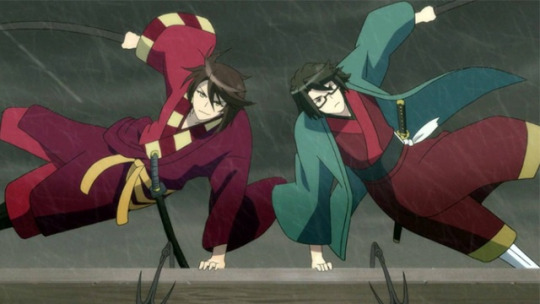
SAO Alicization: The only reason I, a notorious SAO hater, is watching SAO is because I hate myself. With that out of the way, boy is this SAO boring. We’re four episodes in and the only thing that’s happened is they cut an old tree because nothing can stop Kirito and his new friend, Yellow Kirito. This show needs to start getting offensive and/or stupid soon or i’ll die of boredom.
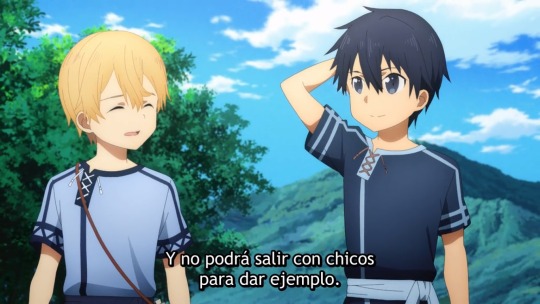
Karakuri Circus: I hear this one’s from the same mangaka as UshiTora? I love UshiTora and I can see the resemblance between giant guy whose name I can’t remember and Tora. His character and his schtick are so far the most interesting thing to me, with the kuudere puppet girl whose main purpose seems to be to get paired with him having yet to make an impression on me. I’m also still not really certain what the overall plot is. I do love stories about found families, so hopefully I can stick with this one

Hinomaru Sumou: If my watching schedule were normal, this wouldn’t be in this section. Whilst not the best sports show of the season, and chock full of some of the most eyeroll worthy aspects of sports shonen *cough cough* toxic *cough cough* masculinity *cough cough*, Hinomaru Sumou has the fire and passion for an underrepresented sport that’s usually enough to hook me. I just don’t have time, and if push comes to shove, I’ll prioritize other shows over this one.
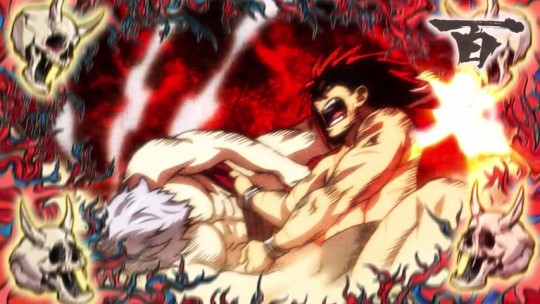
Banana Fish: Yo, okay, before you lynch me for being a hater or whatever, let me tell you I have zero issues with Banana Fish. I don’t hate it, I don’t think it’s Bad Representation(TM) whatever the fuck that means, I definitely don’t think it’s fujobait or just another BL. It just doesn’t make me happy. This probably doesn’t make a lot of sense, but I’ve never been a fan of tragedy. It’s also part of the reason I’m dropping Tokyo Ghoul. I don’t like hopeless stories and tragic romances. I’m somewhat spoiled on how the manga ends and each time I find myself less and less inclined to watch the newer episodes because the descent into misery is just not enjoyable for me. It’s not the show’s wrongdoing, it’s just not the kind of story I like. I’m probably too far along to drop it at this point, but also I kinda wish I could drop it because I get so little joy out of it. Also, my main hook is of course Ash and Eiji’s relationship, but 15 episodes in (I’m behind, as is evident) the time they’ve spent together is so minimal, I can’t even appreciate that a whole lot.

I guess I’m watching this?
Dakaichi: Me: Man I really want a yuri anime without rapey bullshit. Also me: watches BL anime with rapey bullshit. I have literally no excuse. I think the basic setup lends itself really well for a romcom and Takato is a very likable character, it’s a shame it’s the same old rapey bullshit. In my defense, episode two was really sweet and I’ve been hoping for more stories along that line, even though the show has failed to deliver them since. Episode 5 may have pushed the line even beyond what I’m willing to tolerate, but it’s unclear. I might end up unexpectedly dropping it after episode 6. HEY JAPAN WOULD IT KILL YOU TO MAKE A BL ANIME THAT WASN’T RAPEY BULLSHIT? JUST ONE?

(honestly, Takato deserves better)
wao episode 6 was maji disgusting i might drop it after all
Fairy Tail Final: I just want closure man. This adaptation retains all the worst attributes of the previous season, terribly slow pacing (what for?! the manga is over!!) minimal animation, recapalooza. The color palette is slightly brighter than before, which I appreciate. Fairy Tail’s last arc wasn’t as bad as Bleach’s, but it was still pretty bad in the manga; still I hope seeing it animated will make it feel less messy and slightly more coherent. The FT anime has also in the past filled in some blanks that existed in the manga, so hopefully they can make the best out of it here.

(Erza is still my wife)
Tsurune: No, this isn’t the best sports anime of this season either. Although that’s hard to judge given how it’s barely on its second (third, i’m behind) episode. Technically, I feel more compelled to drop this than Hinomaru, but also I want to give it a fair chance. That said, the first episode was.... profoundly underwhelming and borderline upsetting, with how everyone put Minato on the spot in spite of his having an actual psychologic condition that drove him away from kyudo. I’m all in for stories about growing and surpassing your own obstacles, but I hope they go about it in a less mean-spirited way. Also, the characters feel pretty shallow so far. I’m not even gonna pretend the main reason I want to keep watching isn’t gorgeous guy with the ponytail-san, because I’m now old enough that I immediately gravitate towards the senseis rather than the teenage protags.

i am so weak to long hair _(:3」∠)_
welp he cut his hair right next episode, thanks for nothing kyoani
In spite of everything, Anime is, in fact, Good
Golden Kamuy: Like with many split-cours, there’s nothing much to say beyond “if you liked the first one, you’ll like this one”. The production values are still tragic, but I think the pace has improved, and the dynamics between the different factions are so fluid and constantly changing they make the story very enthralling. It also continues to have the Best Reaction Faces.
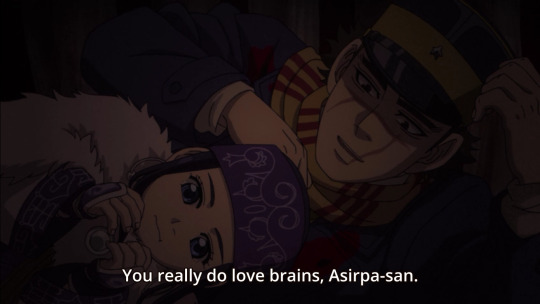
Gakuen Basara: Listen, listen. You all knew I was gonna watch this. And I love Basara so much I still think this show is a masterpiece even when it’s objectively atrocious. I do not reccommend it to anyone who isn’t already a fan (and I mean a blind fan willing to consume anything from this franchise, even in its cheapest, dumbest, worst looking incarnation). That said there are a couple of interesting things, namely the power rivalry between Hideyoshi and Nobunaga, this never happened in the original series because Nobunaga died before Hideyoshi was introduced. Anyway, just shoot that Masamune x Kojuuro fanservice straight into my veins please and thank you
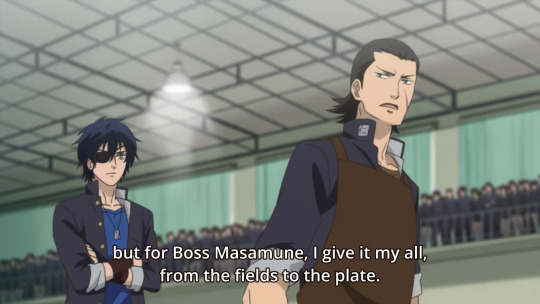
Zombieland Saga: One of the two biggest surprises of the season and one that was nowhere near my radar. An original production by studio MAPPA with perhaps the wildest premiere episode of the season that’s somehow making me like idols?! It’s also giving us the most Miyano Mamoru has ever Miyano’d and it’s amazing and histerical. The characters are also very charming, specially bikegang leader Saki and the always legendary Yamada Tae and the show isn’t scared of letting its cute idols get gross and silly and dirty. There’s also a feeling of mystery that I find very appealing. Definitely didn’t expect this one to be one of the highlights of my week, yet here we are.
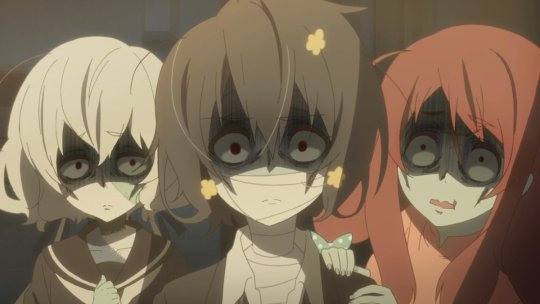
SSSS Gridman: Just when I’d vowed a giant fuck you to Studio Trigger, in they come with one of their most quiet productions yet, with characters that speak their lines in soft, leveled voices, tragedies that feel palpable, emotionally climactic battle scenes and a sense of tension and mystery that makes it impossible to take your eyes away. It does have the caveat of oversexualizing the female characters, specially the villain, and not giving Rikka virtually anything to do, but past that, it’s been a very pleasant and intriguing surprise. Also of note, I have no background knowledge of the Gridman tokusatsu series but that hasn’t really been an impediment to enjoy this series.
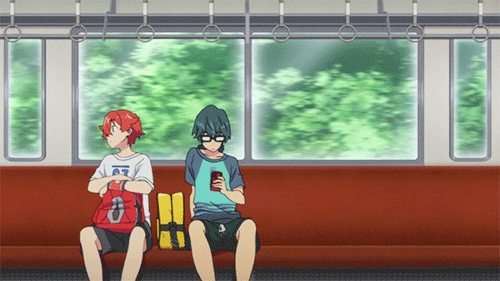
Double Decker: Doug & Kirill: A spinoff to the 2010 superhero hit Tiger & Bunny, we have a less superpowery buddycop comedy with a cool and diverse cast, whose main character wants to BRING DOWN CAPITALISM, okay, put an end to economic inequality and classes, but that’s basically the same thing. The show is pretty far along because it premiered early for some reason, and so far it’s been mostly one-shot stories very thinly connected to the distribution of the illegal drug Anthem, with our main plot having only come up two episodes ago with the fantastic Zabel and Bamboo Man twist. The dynamics between the main duo are great and Kirill is a riot as a protagonist.

Kaze ga Tsuyoku Fuiteiru: Or Run with the Wind. Now THIS is the best sports anime of the season. Brought to you by the studio behind Haikyu, based on a novel by the author of Fune wo Amu. Firstly I love that it’s set in university, because it gives the cast a lot more variety in their interests, ages and personalities, their goals, their baggage, and it makes the process of bringing this team of misfits together even more interesting to watch. The characters feel very human in the way they speak, their worries, their relationships, their actions. The show’s done a great job so far in building the characters and making them worth cheering for. Also Ouji is my spirit animal. If you ever wanted a show to motivate you into running, this is what you’ve been waiting for! Another great surprise of this season for sure.

Jojo's Bizarre Adventure: Vento Aureo: Finally part Five is here! And in it we get perhaps the most interesting Jojo protagonist right off the bat, with troubled Giorno and his difficult past and his wonderful Stand ability. His new set of allies is also quite eccentric and interesting and every scene and dialogue has that special Jojo flavor of crazy and ridiculous and always a load of fun. This one will have 39 episodes, so we’re barely getting started and I’m already loving all of it.
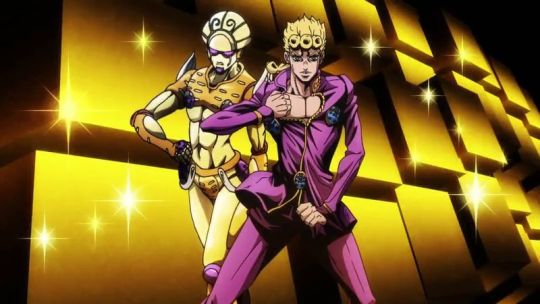
Thunderbolt Fantasy 2: Urobutcher’s favorite puppets are back with a vengeance! Every bit as fun, insane, cool and over-the-top as the first season, with the added value of the rapport between the characters, evidenced by how brilliant the few scenes in which Shang and Lin share the screen are. With a brand new story that expands the world of our favorite puppets, and even more new gorgeous puppets added to the mix to make Shang’s life a mess, this show is definitely my favorite this season and potentially of the year. Let Urobuchi keep doing puppets for as long as he wants!

ooof i’m finally done. It’s midseason so probably nobody cares but do hmu with your favorite shows of the season and if there’s anything worth hatewatching that I may be missing ;)
#anime watchlist#fall anime#thunderbolt fantasy#jojo vento aureo#kazetsuyo#ssss gridman#zombieland saga#gakuen basara#golden kamuy#dakaichi#fairy tail#double decker doug & kirill#tsurune#banana fish#hinomaru sumou#karakuri circus#sao alicization#bakumatsu#tokyo ghoul: re#bloom into you
708 notes
·
View notes
Note
Once you settle down, the dust clears and that Avengers high ebbs to a manageable level... Endgame thoughts? ^v^
I liked the movie a whole lot.
I think Infinity War is an overall better film, but Endgame is a satisfying conclusion to that film, so that counts for a lot. There are some choices I wouldn’t have made with Endgame but it generally worked out in the end so I’m cool with it.
Right from the start this movie rests on the assumption that it wouldn’t exist if you needed to have your hand held through Marvel movie continuity, and that saves some storytelling energy but makes for some curious introductions. Clint’s family vanishes without anyone establishing who he is or that he’s an Avenger. (That he uses the word “Hawkeye” would only be illuminating if the series hadn’t avoided calling him “Hawkeye” for eight years.) Tony provides some exposition in his farewell message but not nearly enough. Captain Marvel rescues Nebula and Tony and brings them back to the Avengers compound without explaining how the Avengers know Captain Marvel or that any of them know to look for Tony at all. I’ve never liked this sort of inaccessibility and I’m not going to change my tune now that it’s happening in my own yard, as it were.
The decision to have Thanos auto-destruct the Infinity Stones made sense (why allow anyone a chance to undo his masterstroke?), although it sent the story in some odd directions. In the heat of the moment, Thanos’s victory leaves you wondering if there’s some way to take it back, or at least go into overtime. So the whole “let’s take the stones and snap his snap away!” thing makes sense. But the reason the five-year jump is so shocking is because it removes us from that heat of the moment, and the idea that anyone is still debating whether to move on at that point is silly. I suppose that’s why it makes sense that Ant-Man (who skips over the five year gap) is the one looking for an instant undo. But after five years, the idea that undoing the snappening is “right” and undoing anything else is “wrong” seems…odd, somehow.
I suppose this is why I was never wild about the time travel rumors that surrounded this movie. It’s one thing to make a story about time travel that climaxes with using it to avert disaster. But introducing time travel for the sole purpose of overturning or redoing the climax feels like a cheap stunt. Endgame deserves credit for confronting this by giving us a reason (Tony’s daughter) to not want the five years erased outright. But that issue could have been addressed without annihilating the Infinity Stones, so that the movie’s epic scavenger hunt would be set in the present. The time travel concept only really adds the fanservice of revisiting key moments in Avengers movie history, at the expense of muddying the scope of the mission.
On that note, let me stop here to discuss a key plot point: Thanos is beheaded within the first thirty minutes of the movie, but then the Avengers’ time traveling attracts the attention of 2014’s Thanos, who follows them back to the present to be the villain of the last sixty minutes. The idea, I presume, is to shock us with the idea that “avenging” Thanos’s victims is all too easy and unsatisfying, but to then nevertheless get a satisfying feeling of defeating Thanos in the third act. It mostly works but it’s clunky, especially when the Avengers are venting their frustrations from Infinity War on a guy who basically missed that movie. This exemplifies the net negative effect of introducing time travel to the plot–I suspect The Lord of the Rings would not be improved by replacing Sauron midway through with a second, backup Sauron. (I am now worried Tolkien nerds will come tell me this actually happened.)
Around the time Captain America was literally admiring his own ass I was starting to wonder if Endgame had gone off the rails, and if I was watching the franchise fall apart in the home stretch a la Spider-Man 3. Don’t get me wrong, the “time heist” stuff is fun and I enjoyed it, but it’s not the epic “Avengers vs. Thanos” showdown I was expecting. Black Widow’s death seemed to rein in the tee-hee tickle party, although it mainly reminded me how much I disliked Gamora’s death in Infinity War.
The un-snappening (that is, Bruce Banner/Hulk using the Infinity Stones to undo Thanos’s “snap” that wiped out half the life in the universe) was unexpectedly dull. Infinity War had a post-credits scene thousands of miles away from the Avengers, with suddenly unmanned cars and helicopters crashing, and it really drove home the Rapture-like devastation of the event. I think Endgame needed a similar person-on-the-street moment, but instead we just got crowd shots of un-dusted people the Avengers personally know. This touches on a quibble I have about the tendency of superhero stories to become self-absorbed–Superman saves Lois and Jimmy so much that you start to forget he has an equal obligation to everyone else. The Avengers movies had generally avoided that trap up to this point, so I was a little disappointed about it.
So, having said all of that...I think the set piece battle with 2014!Thanos pulls the whole movie together. In spite of my misgivings, the first two acts of the movie effectively set up the emotional payoff of “the Avengers reunite, save their friends, and kick Thanos’s ass once and for all.” I’m loathe to judge a movie by its set piece fight scenes, but the four Avengers movies have really elevated the concept--it’s Just What They Do, on a level no solo superhero movie could, and it’s satisfying to see them top themselves again and again.
Perhaps I can explain this feeling in gif form (h/t sheisraging)
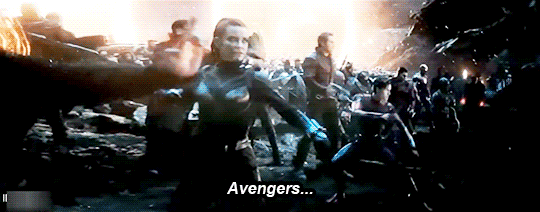
omg is he gonna say it? he has to say it
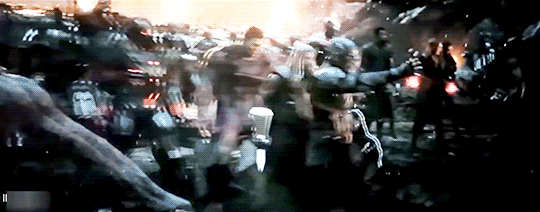
sayyyyyyy iiiiiiiit
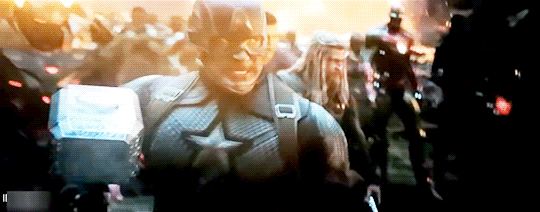
AW HELL YEAH this was worth the price of admission for all these damn movies
As far as the ending goes, I’m cool with where the characters are left for future stories. Tony’s death is sad but the character was basically finished. It’s ridiculous that Natasha died to make Tony’s big sacrifice play possible, and he gets a giant funeral while she’s barely mentioned, but in a weird way it fits Tasha’s nihilistic attitude about her significance outside of supporting her team. I was moved by Thor’s emotional breakdown and gradual recovery, even if I’m not thrilled by the movie’s decision to handle this by turning him into Dude Lebowski. Clint wrapped up his shit two movies ago and deserves to finally get to retire in peace. I missed Banner as savage Hulk but it was probably time to explore smart Hulk since there’s nowhere left for Mark Ruffalo to go with the character. Cap’s decision to return to the mid-20th century raises a lot of questions about how he can truly be happy there, but I’m satisfied that he somehow is/was. By the end of the movie I was ready to let these characters go, and move on to non-Avenger-y things, which is probably for the best.
In conclusion, I have a lot of thoughts about what happened to Steve when he went to put the Infinity Stones back, and I hope to organize them someday...
4 notes
·
View notes
Text
Top 5 Games Of The Year #4
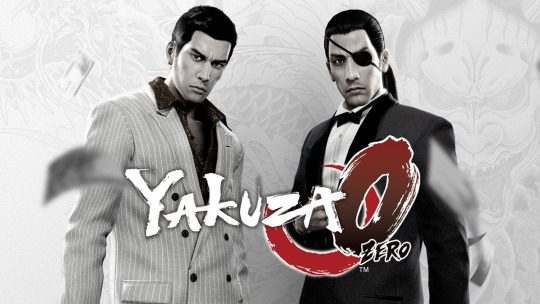
Yakuza 0 is a pretty special game both individually and as a part of its franchise. It’s the first time Yakuza has taken a step backwards chronologically, in order to better explore already established characters and what led them to the events of the first game. It gets a lot of praise already and I’m just here to heap a little more onto the pile because it well deserves it. Although the series at this point is no stranger to having multiple protagonists and Majima has technically been playable before the special feeling Yakuza 0 elicits by having two protagonists wasn’t really lost for it. Compared to the four in Yakuza 4, or the frankly over padded five protagonists in Yakuza 5, taking a step down to just two and placing an almost equal emphasis on each really does the game’s narrative and pacing wonders. Yakuza 0′s story is really good it is an excellent crime drama and among the best main plots the series has to offer. While some might argue other entries, usually 2 or 4, can stand up alongside it I feel 0′s has an edge in some areas. Largely in terms of pace, ambition, and intrigue. For instance, 2 doesn’t really mess around with plot twists, the entire game basically waves a giant flag over Ryuji saying he’s the final boss and the whole plot exists basically just to get to his and Kiryu’s legendary fight. And that’s fine, it doesn’t try to be more than it needs to be and that’s okay. 4 meanwhile has more intrigue and some good twists in there but its pace is much poorer in my opinion. Your mileage may vary on the bullets plot twist, too. 0 has some legitimate plot twists and it does a great job getting players engaged and interested in what’s going to happen next. To get back to 0 though, it doesn’t sacrifice characterization to achieve the quality of its plot either, far from it. It’s the first time we’ve seen a young, hot blooded, and frankly really stupid Kiryu. Kiryu’s never a smart guy but getting to see how he handles situations and behaves before 10 years in prison and subsequent stories smooth his edges and temper his personality is really a treat for fans of the character and newcomers alike. He’s fun, relatable, serious when he needs to be, and most importantly he’s still perfectly recognizable as Kiryu. He is still absolutely that amazing protagonist that you know and love, he’s just young, dumb, and full of.....well you know. On the other hand Majima is almost unrecognizable in this game, being calm, well dressed, a charismatic and professional showman, dissuading others from fighting, all while being openly depressed to boot. This take on Majima still feels fitting because the way he phrases himself is familiar, his gut reactions feel right for the characters, and ultimately this game contextualizes not just his transformation into the Mad Dog of Shimano fans know him as later but many of his actions through the rest of the series. Just ignore how his story here and how he’s written in Yakuza 5 violently contradict one another. We can all just pretend Y5′s Majima writing isn’t canon. The strength of characterization extends to the game’s side characters too, including ones who alongside Majima and Kiryu return from the main series. Nishiki, Kashiwagi, the Lieutenants, Tachibana, Lee, and more are all memorable and great characters. Just, uhh, don’t expect many women in the main plot is all. I don’t want to talk too in depth about the game’s story so as to avoid spoiling anything but it really is a treat. The script takes advantage of player’s expectations in a meta sense, that ultimately this will be Kiryu’s game because, well, Yakuza 4 and 5 were Kiryu’s games in spite of the other protagonists. Those guys all got good, moving stories too and they are all well worth experiencing and having around but ultimately Kiryu is still the most important guy on the block. Not so, here, as by the halfway point of the game players might notice that Majima’s ‘half’ of the game, his half of the game’s chapters, are quite a bit longer than Kiryu’s. Majima has a lot more legwork to do in the story because it is his story, and while Kiryu gets the true final boss fight and is very important to the events at hand as well it’s really Majima who’s the star here. This game is an excuse to explore his character and it does not beat around the bush on that intention. If you are a fan of this franchise you really do have to experience this story. All too often prequel games just end up softening or weakening the existing narratives they’re trying to pay homage to or trying to strengthen but Yakuza 0 expertly dodges that bullet by never missing a beat in terms of quality relative to standard Yakuza entires. My only real issue with the story, honestly, is that Makoto is about as much of a McGuffin as she is a person. The game does take time to develop her both directly and indirectly but ultimately she spends about as much time just being a plot device to be ferried around by one man or another as she does getting to talk and do things. The gameplay is very refined compared to other games in the seires, I would argue it’s tighter and more fun than Yakuza 6′s, even, if only due to the sheer variety of Heat Actions (effectively super moves; ranging from the silly to the bombastic to the brutal to a handful that made me shout ‘HOLY SHIT HE DIDN’T DESERVE THAT!!!’ at my TV) present in 0. If you like beat ‘em ups you’ll like Yakuza’s playstyle; each character gets 4 fighting styles earning three through the story and a fourth through side content. The fourth fighting style for each one is essentially a bonus, letting them fight in their ‘iconic’ styles, Dragon and Mad Dog respectively. To be honest they’re both underwhelming, Mad Dog is maybe Majima’s weakest fighting style and Dragon, while strong, requires a lot more heat than what it naturally builds to stay competent. The fighting styles are still fun though, they add plenty of new and unique options to each character to justify getting them, they’re just not going to win you the game for free or anything. Of the character’s main fighting styles the only real issue I have is the disparity in strength between them, both internally and between each other. No mincing words here, Majima is obscenely overpowered compared to Kiryu. Breaker Style annihilates every challenge in the game with next to no effort besides Mr. Shakedown fights, which aren’t really fun anyway. That said Slugger easily bashes in Mr. Shakedown and even Jo Amon. Majima will breeze through all of his content even on higher difficulties. Comparatively Kiryu can have a pretty rough time in some fights. This is due in part by his fighting styles being really well balanced internally, they’re all useful and thus the player may actually feel like swapping between them mid battle or between encounters. Kiryu not really having an overwhelming option generally means he can be very expressive, my fiancé and I played him very differently for instance on our runs. Whether you most enjoy his fast, invulnerability frame heavy, dash cancelling Rush style which takes a very high amount of investment to become good but I would argue is maybe his best style once you get it there, his brutish item swinging, semi-grappler Beast style which absolutely decimates indoors fights, or the more well rounded, heat action heavy Brawler Kiryu’s got something for everyone. Each of his styles also get a great variety of unique heat actions, all three to environmental cues, and Beast and Brawler to equip-able and overworld items. While Majima’s fighting style are also expressive and a ton of fun to use they just feel too safe and too easy compared to Kiryu. He gets absolutely stellar results and gets them quickly for extremely little effort in the ridiculously fast, low profile attacks of Breaker. Not to say Breaker isn’t fun, because it is, breakdancing to beat people up is hilarious and fun and its heat actions are flavorful to boot, it’s just really overpowered is all. After some investment his Ballerina With A Baseball Bat fighting style, Slugger, also becomes nigh impossible to challenge for the AI thanks to it losing its primary weakness of the bat bouncing off of walls it hits after you put only moderate investment into it. While the least varied of Majima’s styles in terms of heat actions, Slugger is great fun if you ever wanted a proper weapon based fighting style in Yakuza. It feels like what Shinada should have played like. Majima’s starting style, Thug, is a fun grappling and street brawling style that requires a lot of precision to use well and is very well suited to one on one fights should the player be so inclined to not opt for his better options. It makes use of baroque kicks, eye pokes, strangles, and back turns. It’s also Majima’s only style that can make use of non-baseball bat items for heat actions as well as most of his environmental heat actions, and Majima has some GREAT heat actions under these conditions, helping Thug keep a niche compared to the other styles. Honestly, if you like Tekken you’ll probably like Thug. These great fighting styles would be pointless if the game didn’t have fun enemies and situations to pit you against and thankfully it does. Its ‘dungeons’ are a lot of fun and some of the boss fights really stand out. Thanks to the sheer myriad of context based Heat Actions even just fighting the random mooks in the street stays fun for dozens of hours as you experiment to see how you can fuck up some chumps today. It’s deeply gratifying and a lot of fun. While the optional Mr. Shakedown fights are a chore, they are all optional besides the first one so there’s no real reason to bother with them unless you’re doing a 100% substory completion run or REALLY need to grind money in a game where money is already free. Some of the boss fights are a bit mediocre, too, but overall they’re good fun. I do think Yakuza 0 is at its strongest though when it’s making the player fight room after room of enemies, dozens at a time, and just letting them feel like an absolute champion while doing so, really letting them revel in just how strong and cool Majima and Kiryu are. Yakuza 0′s side content is both one of its greatest strengths and in my opinion an area where it shows the most weakness. While Pocket Circuit, Karaoke, Cabaret Club, and the Sub-Stories are absolutely excellent and I truly cannot stress enough how fun they are the game also has a myriad of seemingly half baked minigames based off of real life activities for you to do, a lot of which have unnecessary RNG. Even Bowling has RNG...BOWLING, come on! The Pool, Darts, Bowling, Catfight Club, and other such minigames feel very rushed in execution and for all but the last of those feel like poor simulations compared to other games I have played. Catfight Club is just a really, really, shameless and sexist ‘Watch almost naked women ‘’’’wrestle’’’’’. Also, opposite Majima’s deeply flavorful, engaging, well written, and fun club management minigame Club Sunshine, the aforementioned cabaret club, Kiryu gets Real Estate Royale. Which is about as fun as you think. It’s literally standing around waiting for money to grind for you and then going out and investing it into properties. While the storyline attached to it is decent enough and has some good moments for Kiryu the minigame itself is just dreadful and grossly slow paced. Which is funny to say, because I think it takes less time to complete than Cabaret Club, but it feels like A Lot Longer because it just isn’t fun. There’s the Telephone Club, which uhhh, you can have Kiryu do to get laid. It’s funny in a tongue in cheek way but it’s also not my cup of tea besides laughing at Kiryu’s great dialogue and body language during the interactions. Basically, play Karaoke to hear Kiryu’s beautiful singing voice and also THE ONLY GAME IN THE SERIES WHERE MAJIMA’S SINGING ISN’T JUST AWFUL SCREECHING! 24 Hour Cinderella is a gift to the world and you need to play it. Cabaret Club is also where the vast majority of this game’s female characters exist, as hostesses. While the game could take this opportunity to be sexist (and one could argue it is, for sure) the writing present in Cabaret Club for the platinum hostesses and their story lines is just as good as anything else from the game. They’re worth talking to, learning about, and seeing their development. In all honesty they can almost fittingly serve as a nice break from the game’s intense story, giving the player a breather with some whole and comedic interactions. The Sub-Stories which make up this game’s version of side quests (because yes, this is a Beat ‘Em Up Japanese Crime Drama RPG) are also basically all amazing. The writing is heartfelt, funny, and just really good. They all have strong opening hooks without forcing the player to immediately get involved and despite being 100 of them they’re basically all really memorable. This is also where the game pays Kiryu back a bit for his lost story content relative to Majima, giving him 60 of the 100 sub stories. They’re all great ways to get to see more aspects of these characters and the citizens of Kamurocho, please give a bunch of them a try if you play this game. I also briefly want to talk about the settings of the game, Kamurocho and Sotenbori. They’re literally just the real life Japanese districts, Kabukicho and Dotenbori by SLIGHLY different names. If you play this game enough you’ll know some real life actual locations in actual real life Japan like you’ve been there. You’ll be able to navigate at least a few square blocks of Japan without a map, it’s amazing, and it’s really something special compared to other games. Also, I’m not exaggerating, the overworld(s) of this game are only a few square blocks large but the game plays that to its advantage. Navigating from one side to another of either one takes a minute or two at most and the streets are always PACKED with content. It’s impossible to wander around playing naturally without falling ass backwards into a dozen or more of the game’s sidestories and inevitably getting sucked into playing a few of them and seeing how good they are. I love this game’s map, it’s so brilliant in its design by simply being true to a real life location. Yakuza 0 also sports stellar sound design. The sound effects are BEEFY, hitting things feels amazing and nothing sounds out of place or off beat. The bombastic, over the top hit sounds really sell Majima and Kiryu’s overwhelming power and it just makes every fight satisfying. The soundtrack similarly is good, and while much of the soundtrack isn’t what I would call listening music, the Karaoke selections, specifically Bake Mitai, sure are. I’m not really the kind of guy who can tell you why the sound design is good, it just is, trust me.
All in all, Yakuza 0 is a stellar game and is exemplary of both what a modern beat ‘em up AND a modern RPG should strive to be like. It is a masterpiece in its own right and I’m glad that its success in the western market has secured this unique, beautiful series a future. Please play Yakuza 0, it’s regularly on sale on both PS4 and Steam and it deserves your attention. If you’re ever alone on a Friday night, just remember these Yakuza, and you’ll have a great time.
4 notes
·
View notes
Text
Vidja Games
So I checked out Game Informer’s list of the top 300 greatest video games, and they are objectively wrong, lol (I can’t imagine the fights that went into making this list??)!
I’m no critic, and I’m not interested in attempting to objectively rate games, but here are my (subjective) faves in rough order-ish, if you’re interested! They are arranged by franchise for my sanity below the cut.
The Elder Scrolls (TES)
My all time favorite video game series is TES, although I wasn’t able to stomach playing I and II. In order, my favorites are: Morrowind, then Oblivion, then Skyrim.
Morrowind is unfriendly to casual gamers, and even experienced folks need to learn the lay of the enormous world, how to fast travel, and even how to level and plan characters to best effect. The learning curve is enormous, and if you decide to play a different type of character later on, you’re stuck! You might even have to start over, since you level your character by increasing the major and minor skills you chose upfront.
But I have never experienced such an open, imaginative world. The later installments felt both smaller and less varied. In Morrowind, you’ll find everything from sprawling floating cities to houses built into enormous mushrooms, with ashlands, swamps, and mountainous terrains in between, complete with hell-on-earth smack-dab in the middle of everything.
Oblivion is more user-friendly than Morrowind, and it has some of the most engaging quests in the series. What it loses in environmental diversity and sheer exploration potential, it almost- almost- compensates for in fun quests (there’s much less ‘fetch me some swamp muck’ involved), easier transportation, and the wonderful world of Shivering Isles, an expansion.
Skyrim is the most accessible of the three by far, and it’s forgiving in that it allows players to change their play style on the fly with little repercussions. It also has the best combat. Sadly, the repetitive environments make it far less compelling to explore than its predecessors, which is a huge part of TES’s charm for me. I also found the enemies repetitive. The more fanciful enemies are almost absent, and the few that exist are tied to specific daedric quest lines. Do you know how hard it is to recharge enchanted items when you only encounter a handful of daedra? Wolves and trolls just don’t fill them back up well.
Also, while the accessibility widens the target audience considerably, it cuts into the customization options previously available to more experienced gamers. That was a huge disappointment for me, personally.
To be clear, though, I still adore Skyrim.
Personal anecdote: My Morrowind strategy book was so worn that it fell apart, so I punched holes in the pages and kept it in a binder. I took out the fast travel map and the local map of whatever area I was combing to find a dungeon door tucked into a cave hidden behind ivy or whatever. I still have it; it’s a sentimental treasure.
The Sims
The more open-ended a game is, the more I like it, and The Sims is king of that arena! For me, 3 is by far the best installment. 2 introduced the idea of having types of Sims with personal goals to meet to create direction for the player, but ultimately, it felt like I was stuck with the same five Sims over and over again. The wishes and moodlet system of 3, along with the five slots for personality traits, gave me so much more power to create Sims that felt like actual characters.
I... don’t even want to know how much of my life I’ve put into The Sims...
My ranking: 3>1>2>4
It should be noted that I didn’t mind 1′s lack of direction, since my imagination alone is way more than enough to pull me forward in a sandbox game. In comparison, 2 felt restrictive by creating five character types, limiting me to that in a way I couldn’t ignore.
Personal anecdote: I received the original Sims for Christmas when I was in middle school. I accidentally played from bed time until 4 AM, which is the closest I’ve ever come to pulling an all-nighter.
Sonic the Hedgehog
WHERE DO I EVEN START WITH THE BLUE BLUR.
Sonic was an enormous part of my childhood, guys. I played all the games. I watched both cartoons (the one with Sally and the Freedom Fighters and the one where it’s just Sonic/Tails/Eggman/some robots), I learned to read with the comic books. I have a vivid memory of my brother taunting me by refusing to let me see his comics “because I couldn’t read”... So I spite-learned using the comics when he wasn’t paying attention.
I don’t think I can pick a favorite! As a kid, I played Sonic 3 the most; I was a huge Knuckles fan, so that might have played a role (also the original Sonic was too difficult for me at the time, although I certainly tried). But I also loooooved Sonic Adventure and Sonic Adventure 2. And Sonic Generations was so much fun!
Mario Bros
Lord, I was playing Mario games before I could read, I don’t... Mario has always been around for me, okay? It’s a huge part of my story, and the franchise is so iconic that there’s little for me to say. There are way too many amazing games in this franchise for me to name, but personal faves include: Super Mario RPG, Super Mario World, and Yoshi’s Island.
The Legend of Zelda
This is another franchise where I don’t know what to say... It’s too iconic for me to offer much. Zelda games are known for their exploration and adventure, even from the beginning. Ocarina of Time was a big part of my childhood, but I also adore the newest installment, Breath of the Wild. And I know this may be silly, but I love Hyrule Warriors! I can’t wait to play it on the Switch with all the DLC.
And the music??? Guys????? THE MUSIC?!?!?!
Bioshock
Amazing atmosphere, fun game play, and one of the best stories in gaming history add up to an unforgettable experience. Also a fore-runner to the idea of playing dialogue and recordings while the player explores, a trend that caught on in a huuuge way.
Persona
It’s hard to describe Persona games... They basically combine Jungian psychology with various mythologies, sprinkle in some horror (or glob it on in the case of 3), throw in an RPG, and add a heaping serving of everyday high school life. The games tackle a wide range of ideas and game play, creating a unique experience that has drawn a devoted following.
I’ll make this quick:
3: Best story and atmosphere, worst/most needlessly frustrating game play, very prickly cast lol
4: Best characters and character development
5: Best game play (exquisitely polished game play, really), best overall style, worst story and character development
My ranking is 4>3>5. It should probably be noted that story and character are king for me, so while 5 was incredibly polished mechanics wise, the comparatively weak story and characters sunk it to the bottom of the list for me. It was one of those games where I understood where they were going hours ahead of time, and then they would explain “the twist” to the player for half an hour over and over and over. Frankly, it was... kind of insulting, and soured the experience for me.
Also, Mona, I swear to god, how am I supposed to pass school if you don’t let me study or do my homework because you think I need to sleep at 5 PM every day ahhhhh! XD
Harvest Moon
Oh god, here’s another franchise I don’t want to delve into in terms of hours I’ve spent playing O_O
I can’t even explain why I like these games... In HM, you are a farmer, and your job is usually to prove to the villagers that you’re a valuable member of society so that they won’t evict you from your own inherited property. (I’m curious about their deeds and legal policies, lol. How do you write that clause up?).
These games combine farming with socialization and light dating sim elements, and time management is the name of the game. They pull in players by tapping into the universal desire to create order and advancement.
My favorite installment is Friends of Mineral Town. I also adored Harvest Moon 64, but the controls are sadly too dated for me to replay it.
Pokemon
I’m sure I’ve missed at least one, but I’ve played almost every mainstream release of Pokemon since Red and Blue came out. It must be doing something right, lol!
I’m a huge sucker for games where you choose monsters to raise. It’s so fun to assemble a team based on your tastes and raise them just so!
My favorite release is the remake of Gold and Silver.
Monster Rancher 2
OH MY LORD I played this game to the point where I’m shocked the disc still works. In Monster Rancher 2, you find monsters by placing discs into your Play Station, which each encode a monster. In order to access the strongest monsters, you must raise your rank as a trainer by winning official tournaments.
I wish I could explain why I latched on to this particular game so hard, but... I think it had something to do with the massive variety of monsters, the difficulty of the tournaments (I never did hit S rank, and not for lack of trying!), and the myriad of odd ways to unlock special monsters.
Mario Kart
Seriously, who doesn’t like smiting friends and family on the race track? MK is a fun, family-friendly way to deliver a beat down... As long as you contain your desire to cuss like a sailor, anyway.
It’s so hard to pick a favorite here! It’s hard to top the original for the challenge... But Double Dash and Infinity are contenders, too.
Danganronpa
Danganronpa games are visual novels that mix survival, horror, and crime-solving into a dark, bizarre, unique experience. I’ve written a ton about this series lately, so I won’t delve into it here, but you can check out the danganronpa tag on my blog for more.
Kingdom Hearts
These games are so charming and fun to play! I’ve never completed one on my own- linear games are rough for me- but I’ve seen my husband play them all, even the (many) extra installments. KH2 is probably my favorite, although Birth by Sleep was amazing, too.
Final Fantasy
I’ll admit that I don’t really enjoy playing Japanese RPGs; linear gameplay doesn’t appeal to me much in general. But the FF franchise is famous for its sweeping narratives, imaginative environments, and breath-taking music, and I enjoy them for that. I’ve watched my husband play X-XV, and I briefly joined him in playing XI and XIV. My favorite is probably X... Although I have an enormous crush on Ignis from XV.
My favorite FF game to play is Theaterhythm: Curtain Call.
Mass Effect
How do I say this... I don’t think I’ve ever played a game that better simulated becoming an entire universe’s hero and moral center. In Mass Effect, you shape the world and the political climate in unprecedented ways. By the end of 3, every player is so deeply invested in their Shepard and the world s/he created. In that sense, it’s en epic experience without peer.
Destiny
I love playing Destiny with my husband and our friend! I’m a titan, Tony is a hunter, and our buddy is a warlock, and together, we are... three guardians, lol!
Okay, so the vanilla Destiny release needed some help, but it became a great game with the expansions. I’m still waiting for that breath of rejuvenation for 2, but I treasure the time we spend together kicking ass as a team.
Left 4 Dead
This game redefined what co-op meant to me. I always thought of it as Halo, basically competing on the same team against other players. And yeah, you do that in L4D... But the cooperation angle that this game brought to the table was more or less unprecedented.
In L4D, if your team of ragtag survivors doesn’t work together, it’s unlikely that anyone will survive. I spent a lot of free time in college playing this with my friends spread out over different schools. I had so, so much fun with it.
Although 2 had more varied game play, which was great, I enjoyed the original more, mostly because the online game play wasn’t as loaded in favor of the zombie team. Objectively speaking, though, the sequel was the more robust game.
Personal anecdote: L4D is where I learned about dealing with males online. With Halo, which I also played at the time, I only enjoyed it enough to play it with people I knew. I loved L4D so much that I would log in to play even when my friends weren’t available, which meant that I was teamed with random players.
I have a very feminine voice, which apparently means that I am meant to be treated like crap online. Even though it’s a co-op game, and communication is important, I spent most of my sessions with the headset turned off.
Borderlands
THIS GAME, I HAD SO MUCH FUN WITH IT! The crass humor, the expanse of wastelands, the gun-slinging insanity, the incredible couch co-op! What’s not to love?
Sadly, the sequel was a downgrade from the original, but the first game was an amazing ride. I’ve been considering replaying it with Tony with all of the DLC.
Metal Gear
I’ve never played these myself, but I watched my husband play the first three. They’re so cinematic and goofy and over-the-top and awesome! I love breaking out my Solid Snake gravel voice, too. My favorite is... probably 3? It’s hard to pick between 2 and 3, though...
Disgaea
Hmm... How to describe these games... They’re tactics games, I guess? And there’s a lot of story, too... Game play wise, the later installments perfect what the earlier ones started, but you can’t beat the story and characters of the original. Laharl is still one of my all-time favorite male video game characters. He’s... such a brat? I love him???
Honorable mentions in no order (ie, I’m tired of writing descriptions, sorry to the rest of these games):
Halo, Dragon Age, Fallout 3, Ratchet & Clank, Resident Evil, Portal, Soul Calibur, Tetris Attack, Uncharted, Ms. Pacman, the Batman Arkham games
EDIT: I forgot Nier: Automata and Super Smash Bros! FOR SHAME!
2 notes
·
View notes
Text
Some Thoughts On The Best Movies Of 2019
Honorable Mentions: “Always Be My Maybe” (dir. Nahnatchka Khan), “Avengers: Endgame” (dirs. Joe and Anthony Russo), “Her Smell” (dir. Alex Ross Perry), “The Highwaymen” (dir. John Lee Hancock), “Joker” (dir. Todd Phillips), “Knives Out” (dir. Rian Johnson), “The Laundromat” (dir. Steven Soderbergh), “Rolling Thunder Revue: A Bob Dylan Story By Martin Scorsese” (dir. Martin Scorsese), “Spider-Man: Far From Home” (dir. Jon Watts), “Star Wars: The Rise of Skywalker” (dir. J.J. Abrams), “Toy Story 4″ (dir. Josh Cooley), “Triple Frontier” (dir. J.C. Chandor), “Under the Silver Lake” (dir. David Robert Mitchell), “Waves” (dir. Trey Edward Shults), “Yesterday” (dir. Danny Boyle)
10. “High Flying Bird” (dir. Steven Soderbergh) Steven Soderbergh loves process movies, films where collaboration has to take place in order to achieve a set goal. So, heists. Almost all of Soderbergh's movies have a heist element in the text -- often literally, as with the "Ocean's" franchise or "Logan Lucky"; sometimes deeper, as with "Magic Mike" or "High Flying Bird." This new Soderbergh joint is a fucking blast -- and right from the start, with Andre Holland rat-tat-tatting his way through a fancy lunch with an NBA rookie who's still wet behind the ears (Melvin Gregg, good stuff). On the face of it, "High Flying Bird" is a heist movie, one where we watch Holland's Ray and his dogged former assistant (Zazie Beetz) use shoe-leather to stop an NBA lockout and make themselves a lot of money in the process. But its deeper reading is about a disrupter trying to disrupt again without falling behind the curve (it might as well be about Soderbergh himself). The ideas presented in "High Flying Bird" are so modern its almost as if Soderbergh has seen the future, one where athletes democratize sports in the way so many other fields have been democratized by social media. The production and release of "High Flying Bird" -- it was shot on an iPhone and dropped on Netflix -- are timely too. Soderbergh continues to get over on all these guys, doing it better and faster than most people half his age. Maybe he loves heists so much because he's made a career out of pulling jobs on the unsuspecting for 30 years.
9. “Booksmart” (dir. Olivia Wilde) A classic right out of the box, even in spite of the ponderous discourse surrounding its release. “Booksmart” takes the one-crazy-night structure and core relationship of "Superbad" and mixes it with the heart and sincerity of "Lady Bird" to create a coming-of-age movie that transcends gender and time and finds room to turn Beanie Feldstein into a giant star. This is a god-level performance, paying off what everyone hoped would happen after she played the beta in "Lady Bird." She's the alpha here and tears the movie to shreds. Give her a goddamn Oscar.
8. “Parasite” (dir. Bong Joon Ho) There is always another bottom. “Parasite” starts as one kind of movie and becomes another and the deftness with which it transitions is but one of the many delights buried within what has become a landmark release. Two things to note, before hitting the next blurb: first, the ending montage is unforgettable, quite literally as I’ve often replayed it in my head during quieter moments; and second, the score is the best of the year.
7. “Little Women” (dir. Greta Gerwig) Bigger in scope and bolder in construction than “Lady Bird,” Gerwig’s adaptation of “Little Women” stamps her as one of the best filmmakers working today. No one is able to be as honest in depicting complicated human feelings and as unafraid to portray outright empathy amid conflict. The only downside to Gerwig hitting the rarefied air of an auteur is that she doesn’t seem to want to act anymore. But we’ll take the role switch if there are more movies like “Little Women” on the horizon.
6. “Marriage Story” (dir. Noah Baumbach) Noah Baumbach is never really mentioned when conversations turn to best directors; he’s always felt a tier behind the Tarantinos and Scorseses of the world. But given a second thought, it’s hard to imagine why. Baumbach has been knocking out four-star movies since the ‘90s and “Marriage Story” might be his best. (Thanks to Netflix, it’s also by far his most widely seen; my parents even watched this one.) The divorce drama turned meme generator is typical Baumbach: smart people arguing about life with a bite that doesn’t shy away from showing the underside of humanity. But it feels like his most complete film, a perfect marriage of his earlier cynical work and his buoyant Gerwig period. It goes without saying but let’s say it anyway: Adam Driver is remarkable in this one, giving the best performance of the year. But Scarlett Johansson matches him scene for scene, a reminder of the raw talent she displayed during the “Lost in Translation” years when she was basically Andruw Jones for actors.
5. “Hustlers” (dir. Lorene Scafaria) From the opening tracking shot -- an unbroken take that follows newbie Destiny (Constance Wu in her best performance yet) as she tries to scratch together some cash during her first night at the klerb -- Lorene Scafaria makes her case for a Scorseseian tribute previously done best by Paul Thomas Anderson. But “Hustlers” isn’t a mere riff on “Goodfellas” or “Boogie Nights,” it’s a Trojan horse packed tight with big statements on the long-lasting ramifications of the 2008 financial crisis, the bonds of true friendship, and the way parenthood literally changes the mind of a parent (”motherhood is a mental illness,” Jennifer Lopez’s Ramona says twice during the film, first with a laugh and then later with a tear). It all culminates with a finale that doubles as a punch in the gut, with a monologue delivered by Lopez that should replace Ben Affleck’s juicy dialogue from “The Town” for aspiring actors on YouTube. Through it all, Scafaria controls every frame and sequence with confidence and ease not portended even by her previous solid work. It’s some masterful stuff, as is the way she’s able to tease out powerful performances from her motley crew of actors: Cardi B (lol sure), Lizzo, Lili Reinhart, Keke Palmer, Wu, and, of course, J.Lo, who does Robert De Niro in “Goodfellas” better than anyone else who has tried since 1990.
4. “Us” (dir. Jordan Peele) Oh, hey, “Us” is awesome. A “Twilight Zone” riff mixed with a greatest hits of references (including but not limited to “Scream,” “Jaws,” “The Shining,” “Signs,” “Funny Games,” “The Cabin in the Woods,” and “C.H.U.D.”) that throws a bunch of big, lofty ideas into the batter. Chief among them: How the ruling class must be taken out by the disenfranchised and how the disenfranchised, after wresting power from that class, will not go quietly into the night. (Alternate take: Bury the unwoke person you were as a youth before they can come back and ruin your life.) It all works so well — thrilling and hilarious, often at the same time. Lupita Nyong’o is otherworldly here (best actress 2020) and Winston Duke does an outrageous Jordan Peele impression that should please dads everywhere. Highest praise: During a year when we celebrated the greatness of 1999 movies, “Us” would rank up there with the best of the lot.
3. “The Irishman” (dir. Martin Scorsese) I've never thought to cry while watching a Martin Scorsese movie. That's not the kind of filmmaker he has been previously -- and even the movies he's made that pack an emotional wallop do so with almost surgical precision. Perhaps he's getting softer in his old age, or maybe I am: on my third viewing of "The Irishman" (but really, let's call it what it is: "I Heard You Paint Houses"), I teared up on more than one occasion. The elephant in the room after its release became Peggy and the wrongly perceived lack of agency given to her character. But watching how her relationship with Frank unfolds from birth to death with so few words is the movie's greatest trick. The first time we see Peggy, as an infant, she casts her big eyes on dad; those same glances -- angry, heartbroken, disgusted, pitiful stares -- make up their entire relationship. Only once does Frank experience something similar: after he kills Hoffa (a 20-minute sequence that features little dialogue and no music; we stan), Frank is next shown watching from a church pew as Bill Bufalino gives away his daughter at the altar on her wedding day; it's an act of fatherly love and joy that he'll never experience, not after what he's done hours before. Frank knows it too; just look at his face. A fucking masterpiece from our greatest filmmaker.
2. “Once Upon a Time in Hollywood” (dir. Quentin Tarantino) Speaking of masterpieces: “Once Upon a Time in Hollywood” is Quentin Tarantino’s best movie in 20 years and his most introspective ever; cinema’s former enfant terrible has finally grown up. “Once Upon a Time in Hollywood” grapples with what happens when masculinity runs its course and when one generation loses prominence to the next. But it’s also just super hilarious — filled with moments that are best described as lol. This is the best performance Leonardo DiCaprio has ever given. It’s a remarkable tight-rope walk: he's an actor playing a slightly worse actor who himself is giving a performance and then having to also give another performance as the actor he's playing? As his sidekick-slash-lifemate, Brad Pitt is so effortless that it's almost redundant to praise him. And while there are other delights to enjoy among the cast (Margaret Qualley, Julia “tha God” Butters), let’s highlight Margot Robbie: She finds such warmth and grace within Sharon Tate that it's hard not to leave the film feeling a tremendous amount of sadness and regret. "Once Upon a Time in Hollywood" might rewrite her history, but the real world did not. Unfortunately, this legend was never printed. But at least it exists in the movies.
1. “Uncut Gems” (dirs. Josh Safdie, Benny Safdie) What if the last 30 minutes of "Goodfellas" was actually 120 minutes and starred an all-time Adam Sandler, Mike Francesa, and Kevin Garnett, and prominently featured Billy Joel's "The Stranger"? The Safdie Brothers wrote and directed my fever dreams and it resulted in the best movie of 2019, 2018, 2017. This is a landmark; why bother writing anything else?
0 notes
Text
Knives Out

Among all the languages extant today, English enjoys that lofty status of being the lingua franca. Basically, “Since everyone’s speaking it, might as well then” stature and because of this, it has a certain flexibility in its lexicon. For example, it has acquired certain loan words from other languages. One such loan word is the French “ensemble”. Good ol’ Mr. Webster defines ensemble as “a group producing a single effect”. How appropriate for this wonderfully crafted movie! A group of remarkable actors coming together, as if falling into a movie singularity, but instead of collapsing under the mass of a forgettable script and a meager storyline not giving justice to the talent therein, it sucks you instead into a black hole of pure satisfaction knowing you just watched a thoroughly engaging film.
Movie buffs will no doubt classify this kind of film as a whodunit. Yes, that is still American English so please forgive the colloquialism grammar gurus! These kinds of films are characterized by treating the audience with an intricate plot revolving around a murder mystery. The protagonist is usually a detective or genius sleuth figure who tries to solve the murder by figuring out who the killer is through brilliant deduction skills. For most of the movie, the audience goes along with the sleuth’s soliloquy and his thought process as he works his way through the gallery of “suspects” interviewing, considering and examining them to uncover who the culprit is. Hence, “Who done (did) it?”
The last notable example of a whodunit with an impressive ensemble of stars was Kenneth Branagh’s 2017 version of the classic “Murder on the Orient Express”. Also, growing up in the ’80s, I still have scant memories of when I managed to catch the great Peter Ustinov in the excellent “Death on the Nile” which Branagh is also apparently going to be helming next. Both films were adapted from the books by famed and prolific(!) English mystery writer Agatha Christie.
For this film, a particular narrative style is cleverly used: this is when the movie actually begins in the middle of the story and flashbacks of past scenes are told from the point of view of each character. These recollections of past incidents, however, are often not so accurate, they’re distorted even! Mr. Detective then has to wade through such murky details to arrive at the truth of it all. The effect can be a bit comical at times! This narrative device is called the Rashomon Effect from the seminal 1950 movie of the same name (“Rashomon”) by the acclaimed director Akira Kurosawa from the Land of the Rising Sun. Kurosawa’s pioneering narrative concept has even become a framework for several fields in academia (but knowing that you didn’t come here for a Sociology homework, let’s move on to more exciting stuff, shall we?).
We need to talk about the top tier cast! Some recognizable stalwarts include the esteemed Christopher Plummer as the celebrated writer cum moneyed patriarch and who you instinctively know is going to die for the wheels to turn. The dysfunctional and foible-filled clan is comprised of Jamie Lee Curtis as the eldest daughter with an executive, Type “A” personality and woefully married to Don Johnson’s unimpressive husband role. Chris Evans playing the ne'er-do-well son isn’t really noteworthy for me because he seems to be basically playing himself, or is he? The rest of the clan and their respective brood includes the ubiquitous Aussie Toni Collette who seems convincing as some sort of “celebrity influencer” and also trying to be a mother to a daughter with an SJW bent.
At this point, I’m going to mention my standouts: Michael Shannon taking the role of second eldest with a fairly large chip on his shoulder and quirky son in the background. I am compelled to mention that he is a favorite actor of mine because if you’ve seen 2011’s “Take Shelter” and his role as General Zod in “Man of Steel”, you’ll know the raw talent this guy has. Unfortunately, he is somewhat under-utilized in this movie. This is not totally unexpected since he is part of an ensemble and it’s always going to be a challenge to give ample time for each character to flesh out their roles. A hallway scene somewhere there will provide enough atmosphere to make his presence somewhat felt.
Next is Mr. “007” himself, Daniel Craig comes half-convincingly equipped with a gentlemanly Southern drawl (Yes, I’m not kidding!). Maybe it’s still that British secret agent aura around him that prevents me from embracing his decent portrayal of a private investigator working on the high-profile case. There are times when he operates on quiet intensity, then sometimes with a cheeky grin which looks like he’s trying to suppress.
Last but certainly not least is the Spanish succulence named Ana de Armas. She’s been working steadily in Hollywood for some time and her full thespic talents are revealed in spite of her “body” of work (that was indeed a double entendre, as 2015’s “Knock Knock” and 2017’s “Bladerunner 2049” gloriously reveals). As the caregiver to the recently deceased patriarch, she balances the vulnerable-yet-firm, sensitive-but-gutsy character very well! I’m sure with more fine projects like this, her star will continue to rise in filmdom and I look forward to it.
I must admit I don’t know much about director Rian Johnson except for 2012’s “Looper” which I honestly found nothing special. Apparently, he also directed an umpteenth “Star Wars” product which I also did NOT regret watching. This project though is something noteworthy and the ability to thoughtfully meld a fantastic script with a talented “A list” ensemble in a non-linear narrative is commendable. The pacing of the story arc was just right too.
So the ensemble is more than just the sum of its parts. So much more. This movie works well and does not leave the audience lost and eliciting intense divisiveness with its finale. I’m glad too that these kinds of movies are still being made and are a welcome alternative to the countless remakes/reimaginings, franchises or uninspired efforts of Hollywood these days.
Go see it!
0 notes
Text
After last week’s tidal wave of toy news, we’ll kick back tonight with a couple leftover reveals from the shows, plus Figuarts news both anticipated and unexpected. After catching all that we’ve got pre-orders up for moe model kits, vindicated video games, and boxy dinosaurs, and I’ll leave off by indulging in a look at a very cool toy set from my (and mine alone) favorite Sentai series. Come on in and enjoy some Tuesday Night Toys!

New Stuff: Rest of the Fest
Of course, just after I finished posting my monolithic master-post on all the Toy Fair and WonFes reveals, news of a couple other things trickled out. Diamond Select will be producing Pulp Fiction action figures in their increasingly-desirable premium style, starting with Jules, Butch and Marsellus Wallace (whose toy, thankfully, doesn’t look like a bitch). There’ve been TONS of Pulp Fiction characters immortalized in collectible form previously, but never as straight-up normal-sized action figures like this, so they’re super welcome and they better do more. I’m eager to see all the accessories they include (already loving that backdrop with Jules that has the bullet holes). I hope Wallace comes with a box of donuts.

Meanwhile, at WonFes, it turns out ANOTHER new Amazing Yamaguchi Marvel Revoltech was on display next to that Gwen everyone was gawking at: A prototype of Wolverine could be seen. Wolvie was the one everyone was EXPECTING to be next in the line, and as with the others, the style does him a lot of justice. If you’ve never started a Marvel collection before but were wanting to, this line is quickly becoming the one to jump on.

fuck the police
Bandai and Tamashii started putting out info on upcoming S.H. Figuarts. We got promo pics for the new version of Saiyan Saga Vegeta (that memetic crushed scouter looks even better this go-around), but more importantly, confirmed release info for Nappa! He’ll be a web-store exclusive over in Japan, but Bluefin’s already confirmed they’ll be bringing him over here for general retail (not the first time they’ve done that sort of thing). This is great news, we need more dudes like Nappa in this line. I’m holding out hope that they’ll also do his nearly-naked un-armored form from the second half of his fight.


But the even bigger SHF reveal was that they’ll be producing figures based on the Pokemon anime! SHFs of both Ash and Team Rocket were revealed, and look to be pretty outstanding. I’m fairly certain this is the first fully-posable figure of Ash in his original, Indigo-league design, and we’ve needed a set of Team Rocket action figures for a long time. They even come with Meowth! You’ll also be able to get a special pack of all of them together, which will include a bonus crying faceplate for Ash. It remains to be seen if this will eventually lead to SHFs of Brock, Misty, and any other characters from the show. We can only dream.


Wishlist: Scissor Sisters
The concept of Ultimate Nipako-Chan is a simple one that’s endearing to me: model nippers anthropomorphized as a cute anime girl who likes to build models. Nipako’s fun, and she seems to have hit it off with the otakusphere, inspiring several more figures and even her own manga series! She received a most appropriate iteration in Max Factory’s ‘Minimum Factory’ (I see what they did there) PLAMAX line as a snap-together model kit statue. That came out earlier, but there’s a new pink-tinted version of Nipako’s ‘Spring Version’ up for pre-order now.

Not a week after I’d espoused the surprising virtues of Jakks’s Splatoon Inkling Boy figure and speculated on the possibility of a matching Girl coming out, she was confirmed via pre-orders for the next wave of their World of Nintendo line. If she’s as decent as the Boy was, I’ll happily complete the set. They could also get away with repainting these two in other possible colors. And as I said then, Callie and Marie are totally welcome.

And in the market of tiny desk distractions, 52Toys’s TOPOP Beast BOX line (no relation to Beastbox the Transformer) gets rolling with pre-orders for a little dinosaur guy in a few different color and style variations. These look pretty darn neat, being mini-saurs that fold up into boxes. I might grab one, and keep an eye on any others they could have coming out.

On Desk: Nick of time
Tokumei Sentai Go-Busters is known to have go-busted. Intended as a radical reinvention of the Super Sentai franchise after the previous series Gokaiger succeeded with an overdose on its own style as an anniversary celebration, Go-Busters’s style and storytelling departures from the normal Sentai tropes left it unable to connect with its intended child audience, and it didn’t exactly endear itself to the faithful in the grown-up Sentai fandom either. In spite of, or indeed because of that, I love the series. It holds a special place in my heart as the first one I watched as it was airing, and it’s just so unapologetically unique, and probably will be moreso as Toei will likely never try anything like it again.
Super Sentai toys tend to favor the mecha and the transformation devices over any actual characters, so while I’m happy to have the Morphin’ Brace and Blaster, and the collector-aimed Red Buster Figuarts was a nice purchase, I wasn’t really aware of any other incidental toys that had been made. So I was pretty darn shocked to turn over a set of mainline action figures of Red Buster and his Buddyroid partner, Cheeda Nick! I always knew Nick was designed with a working transformation in mind, but hadn’t been aware that it was in service of a toy. And less than twenty bucks on eBay later, here I sit with an actual factual transforming version of my favorite bike buddy!

The toy’s pretty much everything I could’ve wanted, all told. No cheap BofA Power Rangers corner-cutting here, Nick is fully painted with all of his details, the red especially done in a gorgeous, metallic, ‘candy apple’ style that’s true to the show. The bike mode is spot-on, with all the transformational bits locking down perfectly and nothing too extraneous sticking out (you can see his hands by the rear wheel, but that’s about it). They did make a Figuarts scale version of Nick in just his bike mode, but I’d honestly say you wouldn’t need it with this around; it’s a damn fine version of bike-Nick, and most importantly, it actually transforms!

Ages of seeing Sentai mecha in action haven’t given me much to be impressed by from Bandai and transforming robots. You mostly get boxy, simple shifting into one mode that’s unconvincing, and obvious, with little posability either way. Nick completely subverts that expectation. His transformation is economical, to be sure, consisting of only three or four simple steps, but Bandai works that elegance into successfully recreating his robot mode in just as solid detail as his bike mode. The upper legs, formed from the seat, are a little bigger than on the show suit, proportionately, and the front-wheel ‘backpack’ sticks out a bit more, but other than that, all his lines and design elements look good. His body and limbs are proportioned well, and perhaps more surprisingly, he has a good range of motion!

He’s not super posable by any means (there’s a figuarts of his robot mode for that as well), but he’s got way more articulation than just what he needs to transform. The arms alone have wrists, elbows, bicep swivels, and (somewhat restricted) universal shoulders. The head has a good range of motion, and he’s got ball hips with knees and ball-jointed ankles. Overall Nick can strike some very dynamic poses, and his wheel-kibble guns can be clipped on his hands or removed for additional effects. He’s a really outstanding figure on his own, even outside the lowered expectations of Bandai robots. He even gives Hasbro and Takara’s transforming robots a run for their money!

Red Buster, coming packed with this transforming treat, is really mostly an accessory for Nick, to complete the picture of him being ridden in bike mode. He has exactly enough articulation to facilitate doing so, but amusingly, that still gives him quite a bit of posability. He winds up with basically every critical point save for elbows, and still has plenty of range of motion. And like Nick, all his details are painted pretty immaculately (this is especially jarring after ages of being in toy aisles seeing what Power Rangers ‘vehicle driver’ figures look like). He even includes little Ichigan Buster and Sougan Blade accessories, for more options on or off his bike-bro.

Just finding out this set existed was a pleasant surprise, and for it to turn out to be so good was even more delightful. I really can’t stress to you guys how happy this set makes me. They’re action figures of characters I really liked from a series that’s one of my favorites, and they’re good, fun toys that do what they’re supposed to well. Go-Busters might not be anyone else’s favorite Super Sentai, but it’s got a special place in my heart, and now these fun little guys do too.
Thanks for your time tonight, everyone, and I hope you have fun!
#pulp fiction#wolverine#dragon ball z#pokemon#nipako#splatoon#nintendo#Tokumei Sentai Go-Busters#go-busters#super sentai#toys
2 notes
·
View notes
Text
My Top 10 Games of 2016
Man I'm glad 2016 is over but the games were good...
Some years play rough and 2016 was one of those years and I am very happy for it to be over. On the other hand in terms of video games, and only video games, this was a really great year. From a really solid resurgence in the quality of triple A shooters, to the Juggernaut that was Overwatch, and some really solid indie releases, there were actually too many good games for one person to play. Also there was a massive update to DotA 2 this year which is always welcome. So here we go, my top ten games of 2016.
Honorable Mention - The Final Station
Of all the games I played this year I had the most intense reaction to The Final Station. Upon completion of this game I set aside my controller, turned off my monitor, not the PC, just the monitor, then I went for a walk around the block. I was moved to this act not by any great aspect of the game’s production or by some jaw dropping set piece but instead by the oppressive weight and bleakness of The Final Station’s world. A dangerous world where even the simplest task can expose you to being torn apart by brutal attackers. A world where infrastructure is crumbling and the people normally trusted with protecting everyone have secretly betrayed the trust of the people. After the way 2016 played out, the bleak outlook of The Final Station resonates even more.
10 - Pokemon Go
I am not a Pokemon fan. I fully recognize the good and great qualities of the Pokemon universe, but the games and cartoons have just never done much for me. The runaway success of Pokemon Go demanded that I give the game a shot despite my usual lack of enthusiasm. What I found was a really solid AR experience filled with tons of excuses to get me up and about in the real world and a great new icebreaker to start conversations with people I would otherwise have nothing in common. Oh yeah, and some weak ass Pokemon.
9 - Reigns
Reigns is a truly fantastically simple game. Of the two mobile games on this list Reigns is the one that fit into my life the best. In that way Reigns was the anti Pokemon Go; Pokemon Go was the mobile game that changed my routine and Reigns was the game that fit into my routine. When you’re waiting in line for the movies or whatever you can’t go running after that stupid Zapdos. But you know what you can do? You can live the lives of half a dozen Medieval Kings, you can meet the devil in the form of you dog, you can fight skeletons in a dungeon, and even more cool stuff. Also it’s a mobile game that you just pay for up front and it never bothers you for money again, which is always nice.
8 - Darkest Dungeon
Fun fact: for most of my 2015 Extra Life Marathon I was having internet service issues and about the only game I could reliably stream was the early access version of Darkest Dungeon, so I have more than a little experience with the game. The way that every part of The Darkest Dungeon works together to to create a gothic horror landscape is just fantastic. The way the cartoony artstyle contrasts with the animation and sound design is just dissonant enough to be unsettling. The way that the psychological maladies effect the gameplay and can just straight up end a dungeon run or in some cases even end a game is a risky gamble that really adds a sense of tension that works incredibly well with the tone of the game. Ultimately Darkest Dungeon is a really great, creepy, game. Be ready to grind a bit though because you'll definately need to.
7 - The Banner Saga 2
In a year when the second entry in the XCOM franchise was a disappointment there was a shining star in the turn based strategy genre and that star was The Banner Saga 2. Where XCOM 2 made the mistake of assuming players had maintained their skills from the first game The Banner Saga 2 eased players back into the combat system with a few easier battles before dialing up the difficulty. It also doesn’t hurt the game that it has some of the best hand drawn style art and animation of any game ever. Bottom line: The banner Saga was the best turn based strategy game released this year and I really like that type of game.
6 - Overwatch
I really enjoyed my time with Overwatch this year. Zarya is top tier A-plus defensive tank, and is also just the best. The way that Blizzard has built not just a great multiplayer game but also the UI framework around that game which celebrates every player’s contribution is a great accomplishment. I think that the characters in Overwatch are all really fun as is the game itself. It’s just a shame that there’s really no good single player experience in the game and that the story exists entirely outside the game, and that the community for that game is becoming toxic in spite of some masterful design efforts to combat that. Also shameful is Blizzard's decision to add the worst free to play practice, blind loot boxes with repeats, to a full price retail game. Overwatch is a really great game that is slowly getting worse over time and that’s kind of sad.
5 - Dark Souls 3
Dark Souls 3 is my first Souls game so I was unprepared for the absolute savagery with which this game assails players, even in the tutorial. Once I played for a while, though, patterns began to reveal themselves and a game that seemed ferocious at first became simply challenging but fair. The appeal of Souls games was lost on me for a long time. I couldn’t understand why people were so excited to play blatantly unfair games. Now that I’ve played one I understand that these games aren’t really unfair or even onerously difficult. Souls games simply operate at a different tempo from other games and learning that tempo is the really difficult part of mastering them.
4 - Stellaris
Just. One. More. Turn.
Getting you to say that after 8 hours is the ultimate goal of all games like Stellaris. What Stellaris offers you that others like it don’t is freedom. Freedom to design your own civ, freedom to find your own way to win the game, freedom to be weird. Games like Stellaris, most notably the Civ series, tend to force players into a few basic strategies. Sure you can try a pacifist playthrough in a Civ game but good luck actually winning or even surviving very long that way. Stellaris has a way of making all playstyles viable by making them all just flawed enough that really drew me in to an extent greater than any other game I played this year. That said I tend to be fairly biased in favor of this type of game in general so it’s not a huge surprise that it affected me this way.
3 - Doom
Doom is a game about momentum which is important because that is the way it is different from practically every other game this year. The new hotness in games lately has been agility; letting players flit about the environment hither and thither. Doom ignores this trend, almost with disdain, forcing players to keep their feet mostly planted on the ground but letting them move at unheard of, in recent years, speed across it. What this means is that Doom isn’t a game about not getting blasted so much as it is a game about blasting things. The whole point of the game is to treat enemy encounters the way the Kool-Aid Man treats walls. This isn’t just a return to form to the series because this year’s DOOM added a new piece to the old formula; storytelling. In DOOMs of yore story was an afterthought for the most part. This DOOM, though, actually has a story with a plot and everything and actually interesting supporting cast members. This game even managed to give the “Doom guy” a little bit of a personality and for that alone it will go down as maybe one of the best shooter campaigns ever. In a year where the most popular game is often about five opposing team members finding ways to keep you from killing the sixth Doom is a breath of fresh air, letting you really cut loose against a horde of angry demons released by the worst kind of short sighted corporate greed.
2 - Hyper Light Drifter
I’ve said this a lot this year and I’m going to keep on saying it, because apparently it needs to be said. Everyone, play, Hyper Light Drifter. As a medium video games are often criticized, occasionally correctly, for being too over the top. With that being the case Hyper Light Drifter is possibly the exception that proves the rule. Which is to say sublimely simple and quiet but also incredibly fun and engaging. It doesn’t hurt that the game has the what is probably the best pixel art and sprite work in a game since Fez, an amazing synth heavy soundtrack and great sound design overall. The real beautiful aspect of Hyper Light Drifter, though, is the gameplay, specifically the combat. Few things this year have been more satisfying than mastering the combat in Hyper Light Drifter. The combat is just different enough from other similar games to be challenging while being familiar enough to not be off putting. But more than anything about the game it is the quiet tone of Hyper Light Drifter that impressed me. So what are you waiting for. Go play this game!
1 - Titanfall 2
Titanfall 2 is a truly magnificent accomplishment in game design and execution. Every bit of the game is impeccably well done, it looks and sounds amazing, plays like a dream and most importantly is a joy to play. While a lot of games have the kinds of traversal mechanics that Titanfall 2 has, nothing feels like Titanfall 2. That is what makes this the best game of the year, the way it feels. More than any other aspect of the medium, feel is what defines and differentiates games. In a year where great games were built to make you want to gamble on a loot box or increase accuracy of your favorite GPS app, the relative purity of Titanfall 2 makes it stand out. Instead of trapping players in a restrictive character class Titanfall 2 lets people customize almost every aspect of their multiplayer loadout. The game is even more distinctive on account of its campaign, remember those, which is a masterclass in how to pace mechanics. Titanfall 2 is constantly introducing and discarding new, interesting gameplay mechanics and consequently never gets dull or repetitive. When the mechanical brilliance of the campaign is put together with Titanfall 2’s solid “A boy and his robot” story and one of the year’s standout new characters, BT 7274, and you get, arguably, the best campaign of the year.
As parts of video game industry more and more often leave out parts of their games so they can sell them to us later or add sleazy free to play hooks to games they also expect us to pay for up front, it becomes important to celebrate games for simply being complete experiences on release. Unlike some games on this list Titanfall 2 is at that and more, the best game of the year.
#Titanfall 2#Hyper Light Drifter#DOOM#Stellaris#Dark Souls 3#Overwatch#The Banner Saga 2#Darkest Dungeon#Reigns#Pokemon Go#The Final Station#Top 10#Game of the year
1 note
·
View note
Text
Superversive Review: Star Trek Discovery, Season 0.5
It’s basically a given at this point that any entry in a long running franchise is going to generate a lot of emotional turmoil. Some of us are happy to return to a beloved universe. Some of us are angry that people would dare. Most of us are afraid of how they’re going to screw up the beloved franchise. Most of us, I think, want our franchise to move forward, and the people who are in charge of those franchises are determined to play it safe– or what they perceive as safe. Prequels, prequels everywhere! Brave persons of color! Womyn in charge! Shamelessly mine the canon where you need to, toss it out where it constrains you!
As a kid who grew up with Star Trek, the initial announcement of Star Trek Discovery thrilled me. We’ve had our ups and downs, the franchise and I, but the sight of that Starfleet arrowhead filled me excitement. And then… nothing. Nothing for a very long time, beyond rumors of trouble. When the first glimpse of the ship came through, it was an idea that’s clever on paper (What if we took the unused Ralph McQuarrie redesign of the Enterprise and made that our ship?) and just… didn’t work. Star Trek’s leading ladies have always been the ships, and they’ve almost always been beautiful, but Discovery made the NuTrek Enterprise look graceful. When “plot” details were revealed, they were basically things like “We have a gay couple!” and “Our lead is a woman of color! The first black lead in a Star Trek series!” (She’s not.) Things started to look worse and worse, and then CBS made the decision to release it on Netflix everywhere except the US, where we’d have to pay for CBS’ streaming service…. Well, I decided to ignore it.
Until CBS offered the service free for a month. Nine episodes and a month to watch them? No problem.
Star Trek Discovery follows Michael Burnham, a foster child of Sarek and Amanda, raised on Vulcan, now a Starfleet officer. When the series opens, she’s the first office aboard the USS Shenzou, under the command of Capt Phillipa (Michelle Yeoh), when they run across Klingons for the first time in decades. Burnham tries to convince Phillipa to lead by opening fire on the Klingons (which the Vulcans did for centuries after their first disastrous encounter), and when her Captain refuses, she uses the world’s least effective nerve pinch (Maybe because Burnham is human? Maybe because Michelle Yeoh is awesome?) to incapacitate the woman just long enough to start her mutiny. Long story short, war with the Klingons starts, Phillipa’s killed, Burnham is sentenced to life in prison, and most of the survivors of from the Shenzou are reassigned to the Discovery, a research vessel.
Discovery is a testbed for a new sort of FTL, a “spore drive” that uses the spores of some sort of transdimensional fungus to jump instantaneously from place to place, and for reasons of plot, her commander, one Capt. Lorca, wants Burnham onboard to help weaponize both it and a giant, transdimensional space tardigrade that feeds on the fungus spores when it’s not busy slaughtering people who are trying to slaughter it first. It goes without saying that the the ability to jump to any point in the universe is highly useful in a war, and Discovery, despite being a nominal research vessel, becomes the keystone in the Federation’s offensive. (But let’s be honest: Starfleet is always spouting that “We’re not a military” BS when every single one of their ships is armed to the teeth.)
“I’m a homosexual Lego man! How diverse are we!”
So how is the show? I’ll be honest. I was prepared to hate it, and the part of me that was hoping for some schadenfreude is kind of disappointed to find out that I don’t. The show is not without its flaws. It really bugs me that this Starfleet visually looks nothing like the Pike-era Starfleet, despite being roughly contemporary. It bugs me that the Klingons were redesigned as much as they were, even though it’s not the first time that’s happened. It bugs me that we had to give Spock a foster-sister, who is so Vulcan that Sarek, of all people, has to chide her for her lack of courtesy. There’s a random F-bomb in one episode; Klingon nipples in another. Harry Mudd shows up, but he’s more of a sociopath than a lovable con-man. Michelle Yeoh was underused. Captain Lorca is kind of unhinged. The actor who plays one half of the aforementioned gay couple is actually really fantastic, but the other actor is ridiculously off-putting, with fewer points of articulation than a Lego man, and seems to have been hired for his ability to give off “I’m gay!” vibes. And, irritatingly, a lot of these issues (at least the story ones) could be fixed by making Discovery post-Voyager, or by doing things like having Burnham fostered by a different Vulcan. It really didn’t have to be Sarek.
In spite of all that, I found myself surprisingly entertained. I’m not bothered by the silliness of the spore-drive: Star Trek likes to pretend it loves science, but it really just sort of smears itself with science jelly as a sort of mating ritual. The fact that the spore drive doesn’t appear anywhere else in Star Trek just suggests to me that something is going to go horribly awry with it (and the midseason finale certainly points that way). The story told is compelling in spite of the occasional times it shouts, “Then this happened, because of plot!”
Doug Jones, as always, does a fantastic job when decked out in 7,000 pounds of makeup; the man is the practical effects version of Andy Serkis. Discovery herself isn’t entirely hideous (although the spinning saucer section during spore jumps is ridiculous). The story of what I can only assume is a ultimately fatally flawed super weapon in the hands of the good guys, vs. the Klingon superweapon (cloaks), is at least interesting enough to carry us through multiple episodes. I’m not bored by it.
Weirdly, I feel like Discovery hasn’t completely lost the soul of Star Trek (Though The Orville remains the Trekier Trek). There’s a trick I use for making Star Trek Voyager‘s adventures in incompetence palatable: Not every ship in the fleet is the Enterprise. Not every captain is competent. Voyager was the story of a ship that disappeared and provided an adventure of the week for Picard or Sisko in the form of investigating its disturbance. A similar construct seems to have formed in my head for Discovery: Not every captain is a good man. Discovery is the story of a captain who is eventually going to go rogue, and provide the adventure of the week for Kirk, when he has to fight a famed and decorated former Starfleet officer.
Star Trek Discovery is balanced on the blade of knife, and it could fall any way. It could give in completely to the modern love of grimdark subversion; or it could struggle its way out from under the weight of its the less than stellar hand its creators dealt it to become something genuinely good– you can see hints of a great show here and there. (Notably, the episode “Magic to Make the Sanest Man Go Mad,” and in particular, the last five minutes of it.) One thing I have to wonder is if this show had been named anything else, if the Federation had been “the Republic” and the Klingons “Snorfblats,” if it might not have been a much more highly regarded show. The name might carry power, but with that power comes expectations.
I’m still pretty ticked about not having it on Netflix, though.
Joshua M. Young is an underemployed theologian, sci-fi author (featured in Tales of the Once and Future King, Forbidden Thoughts, and author of the forthcoming novel Do Buddhas Dream of Enlightened Sheep) and blogger at Superversivesf.com. He can be reached on Gab.ai and Twitter @BadgerSensei. If you enjoyed this, we’d love to have you visit our main site!
Superversive Review: Star Trek Discovery, Season 0.5 published first on http://ift.tt/2zdiasi
0 notes